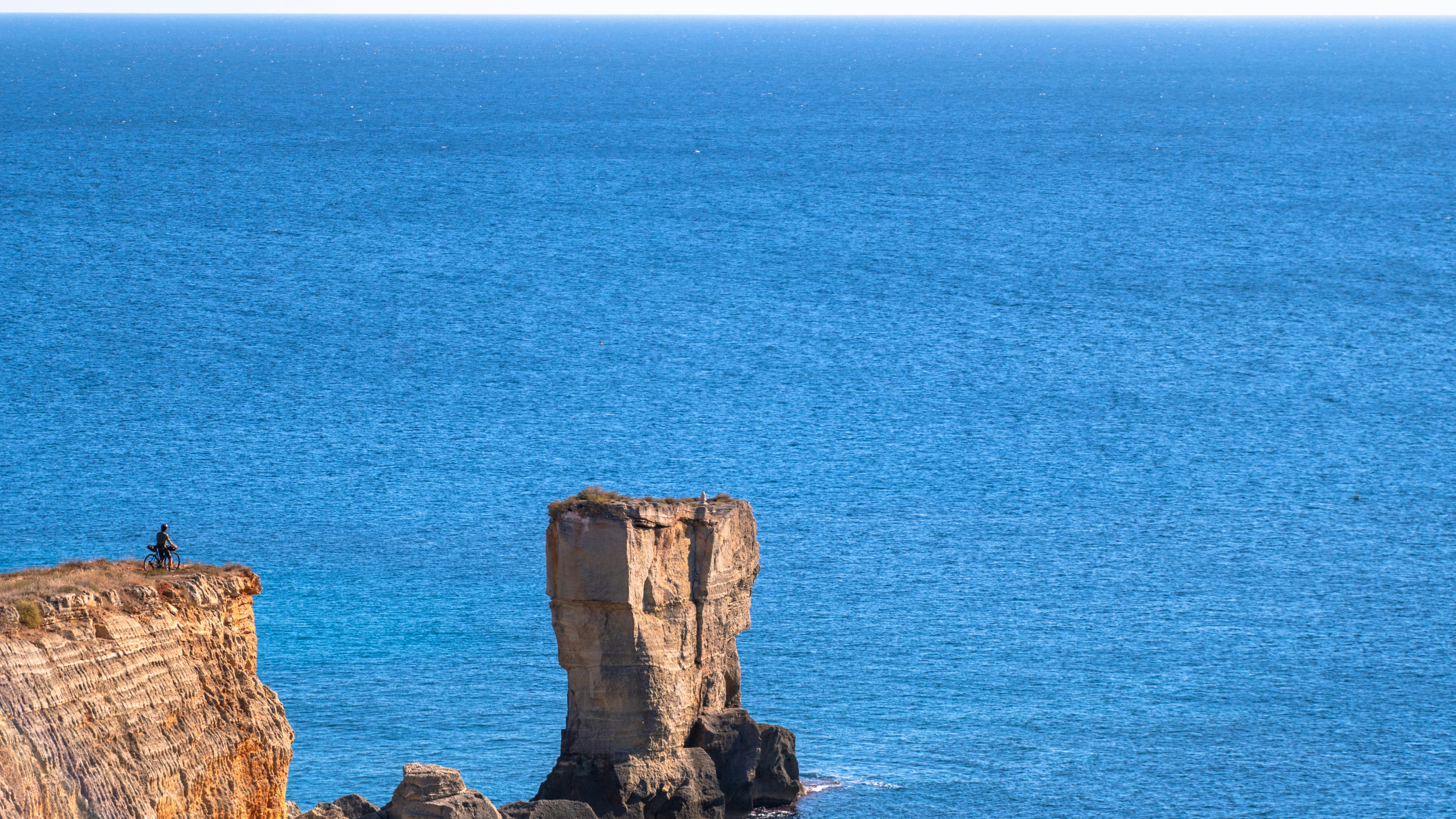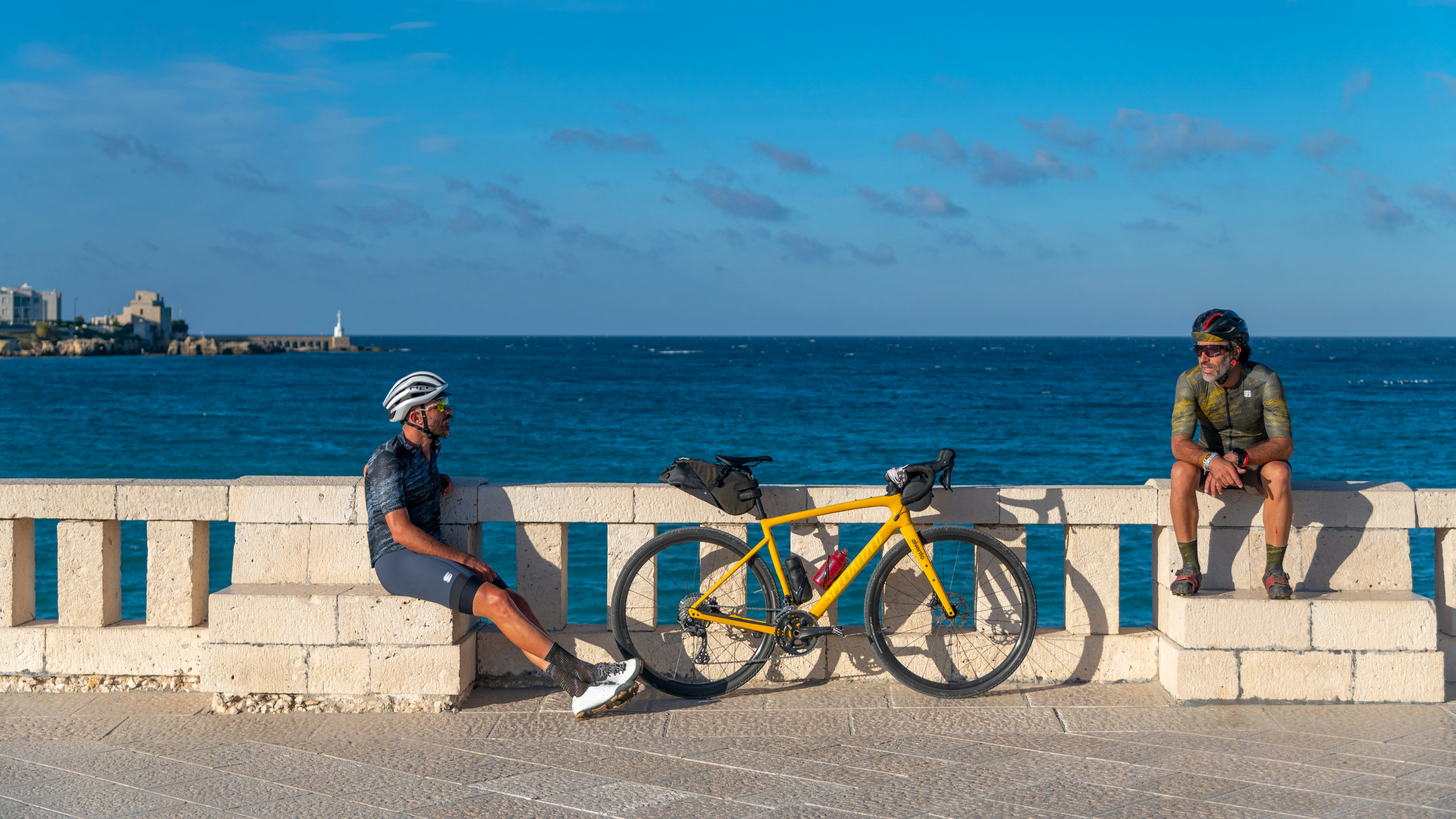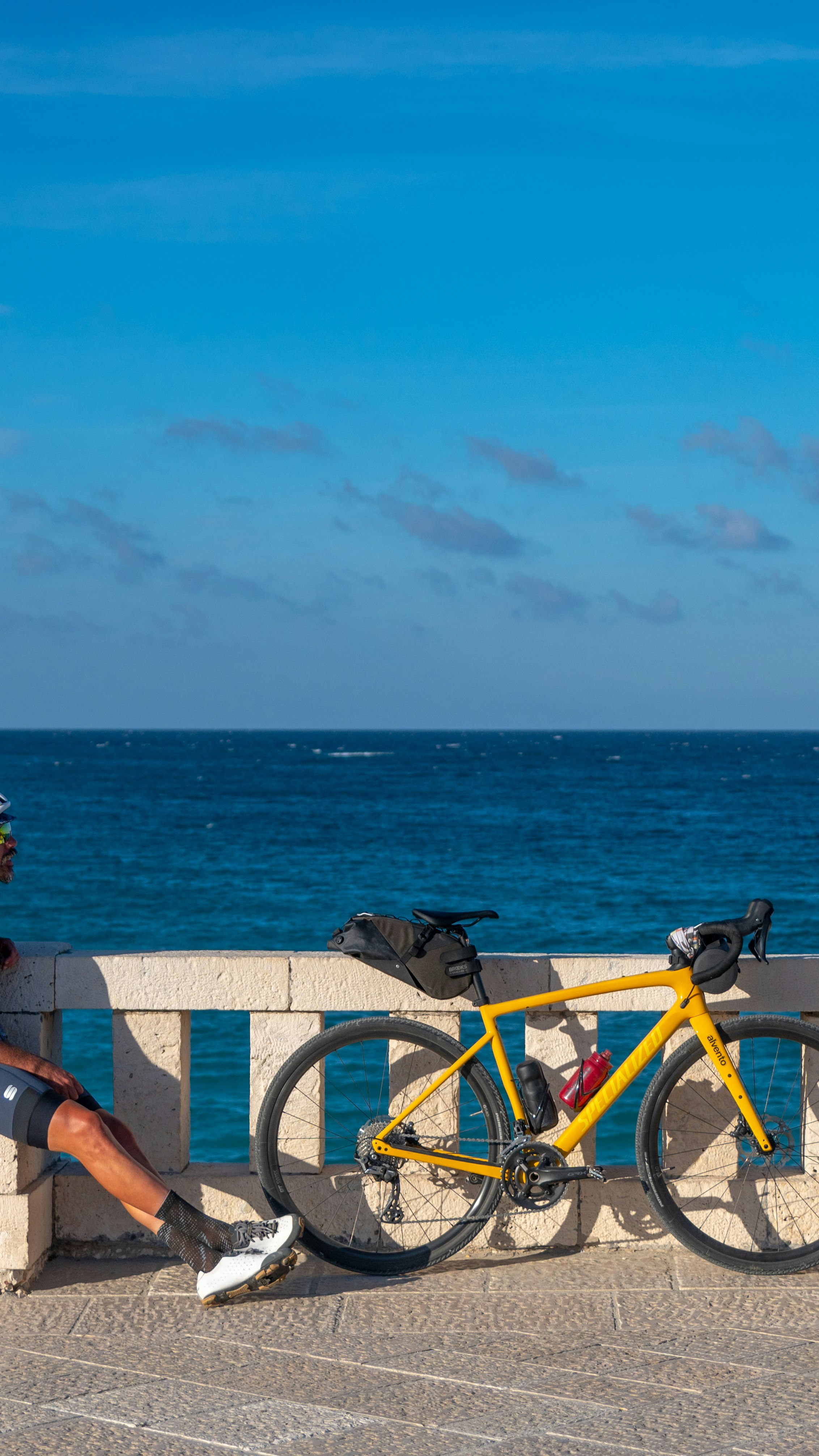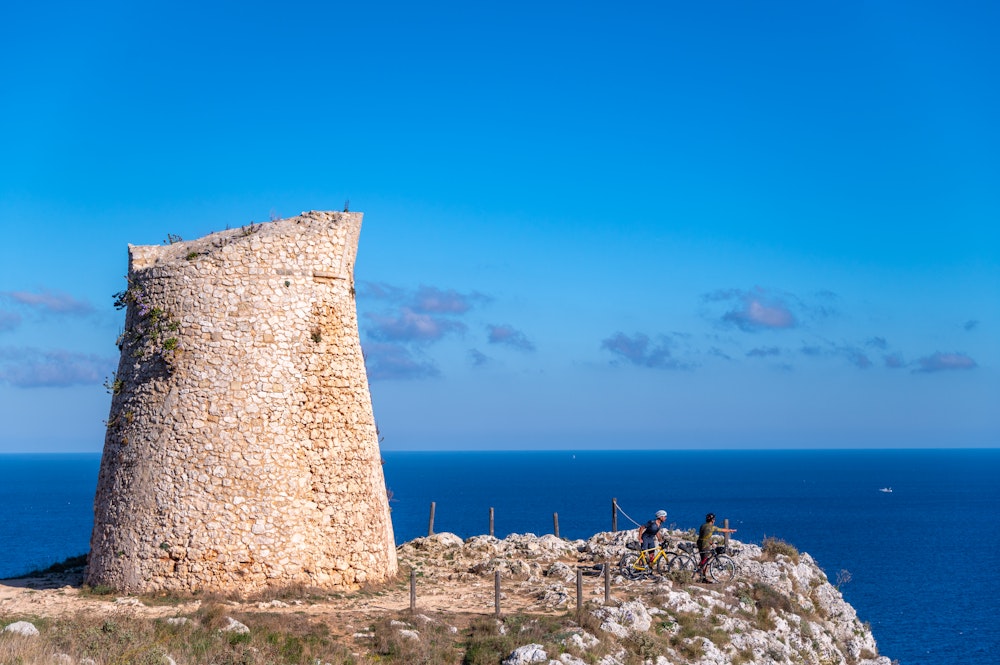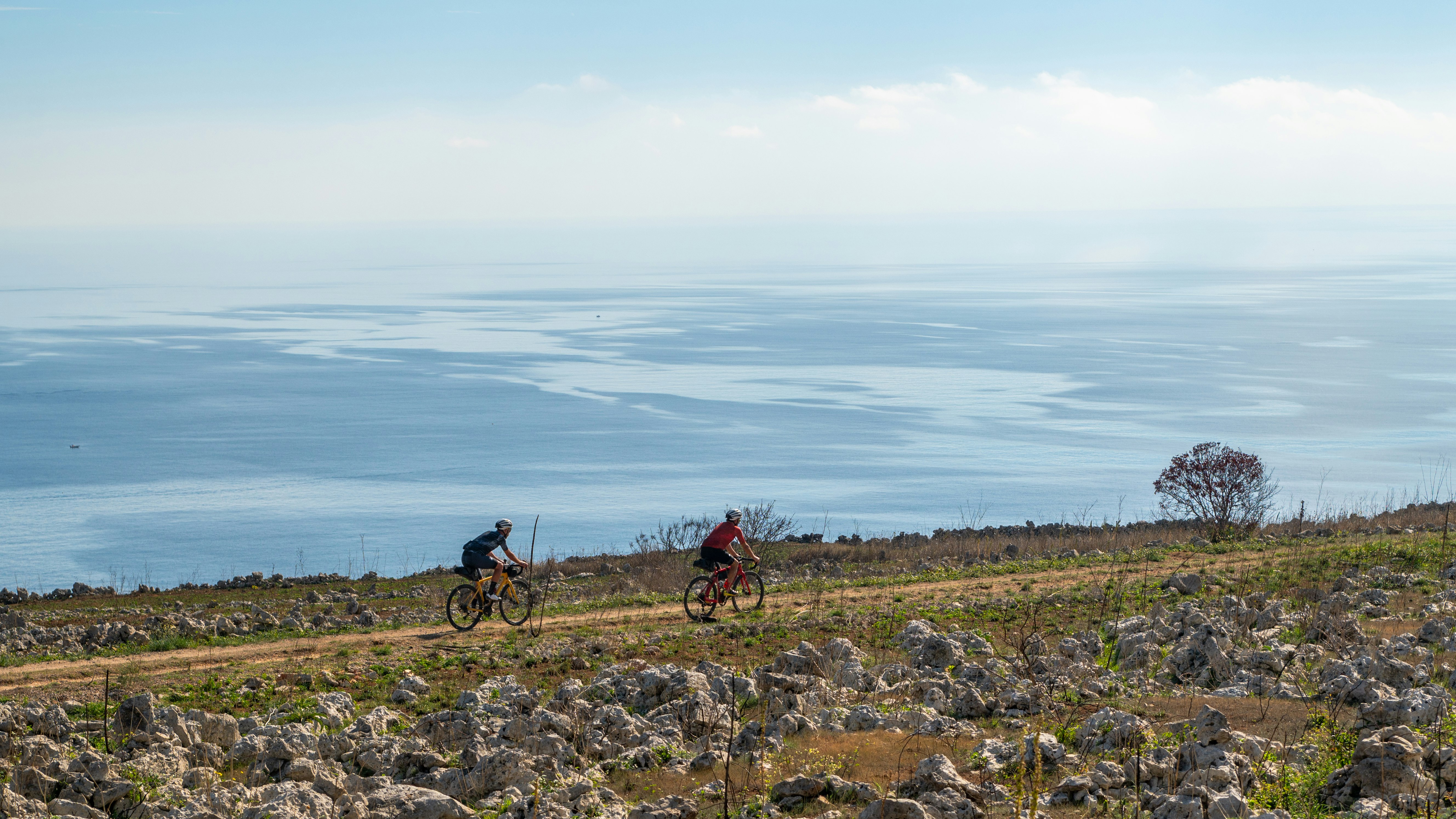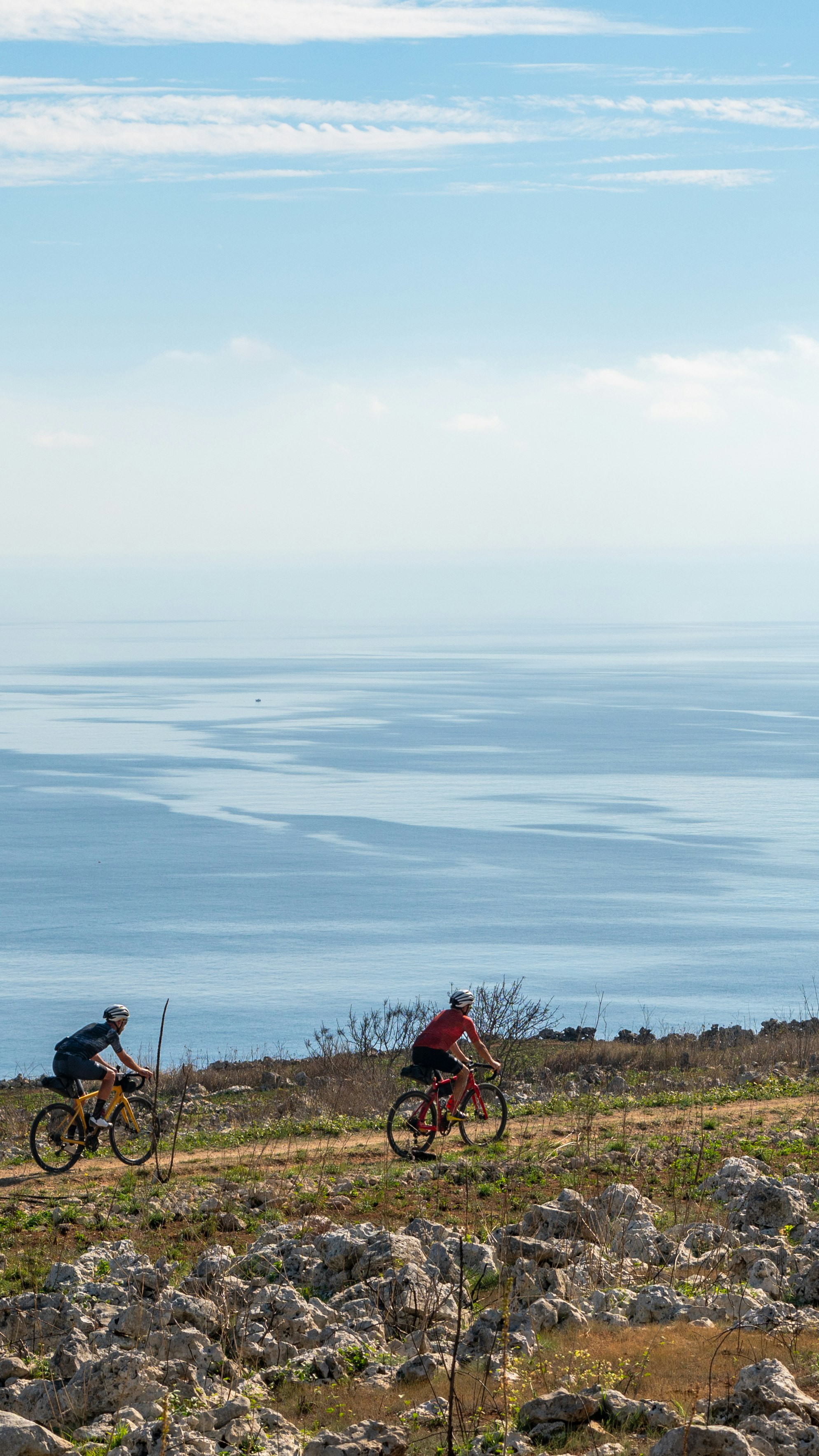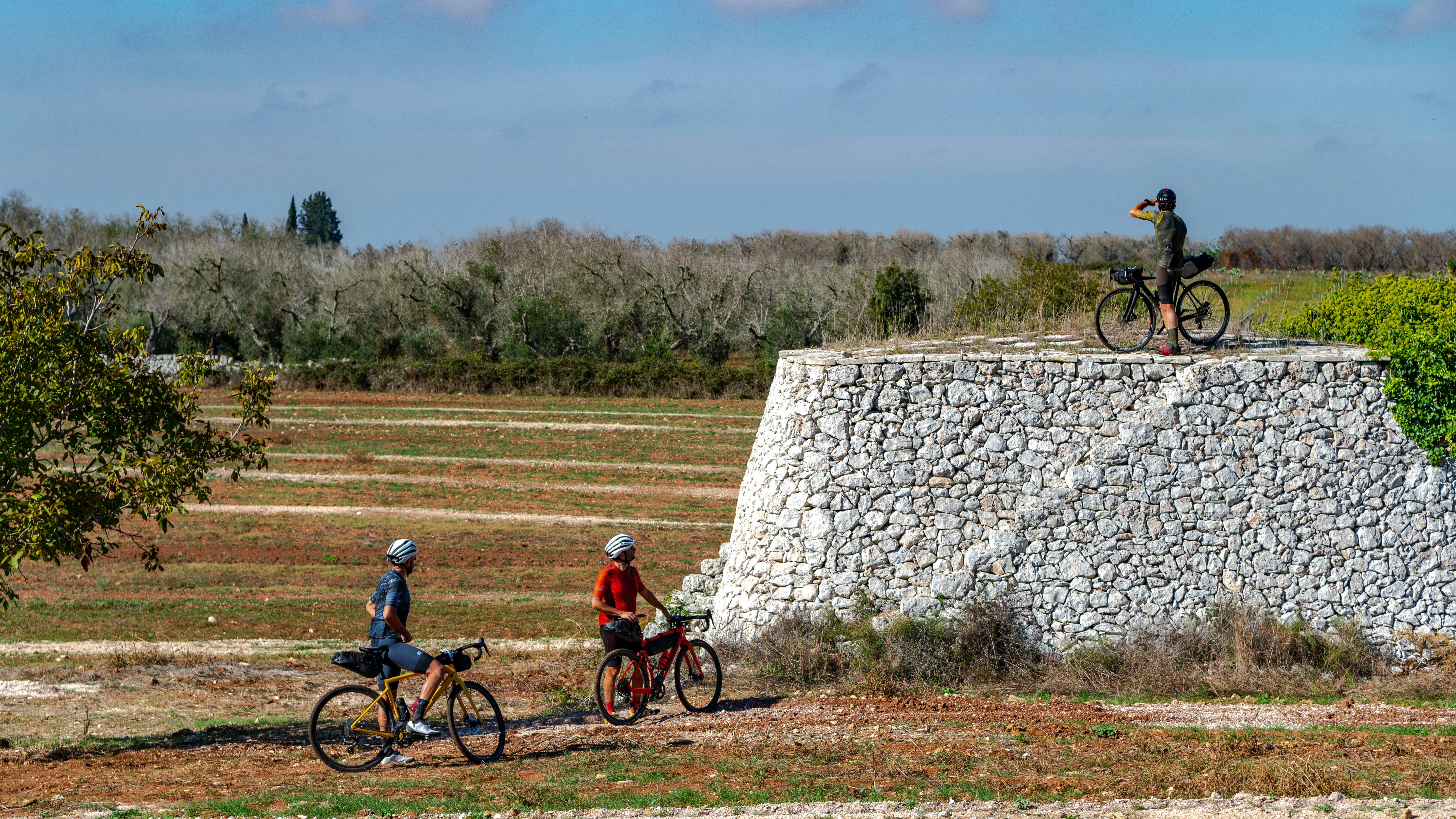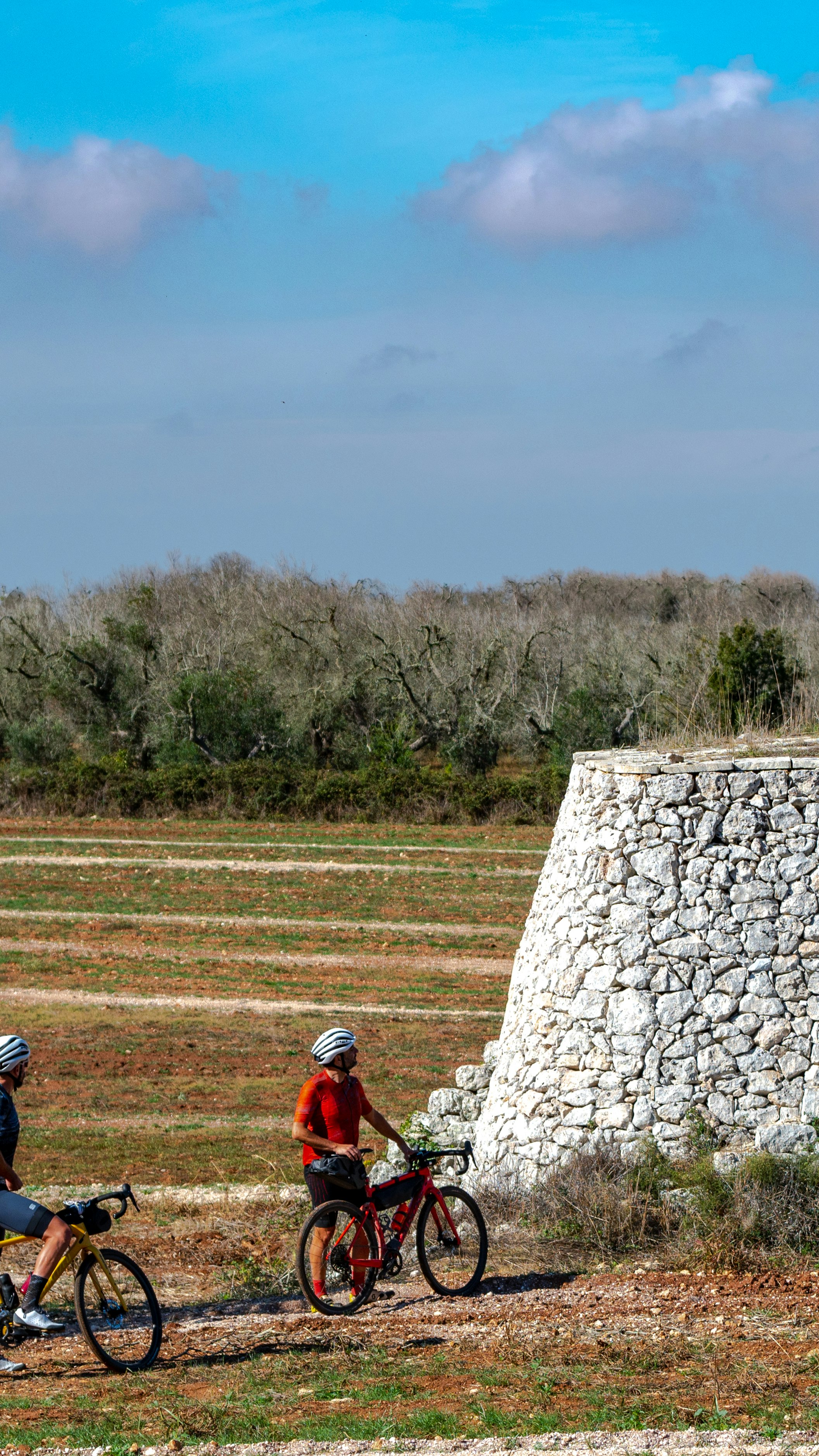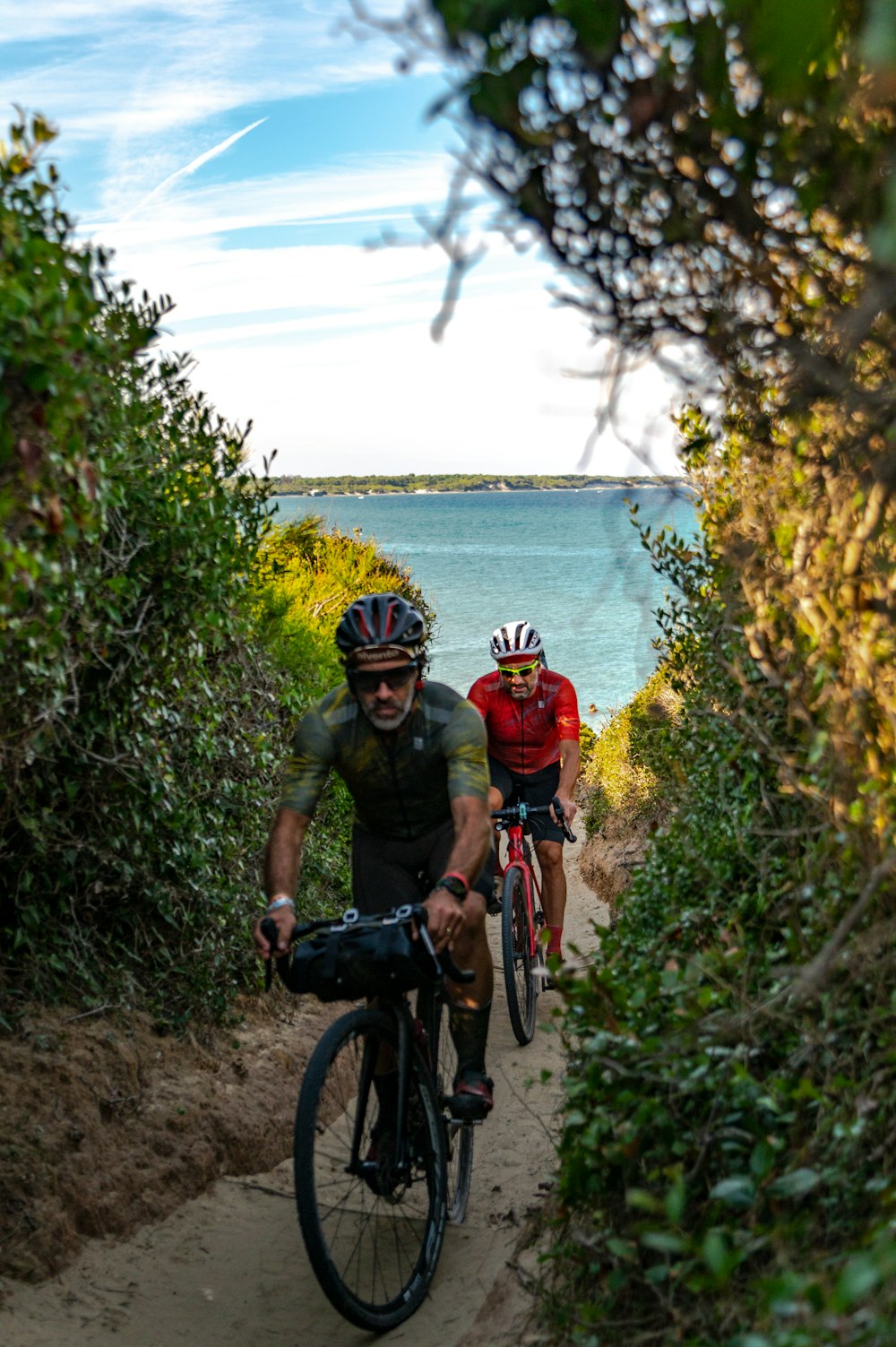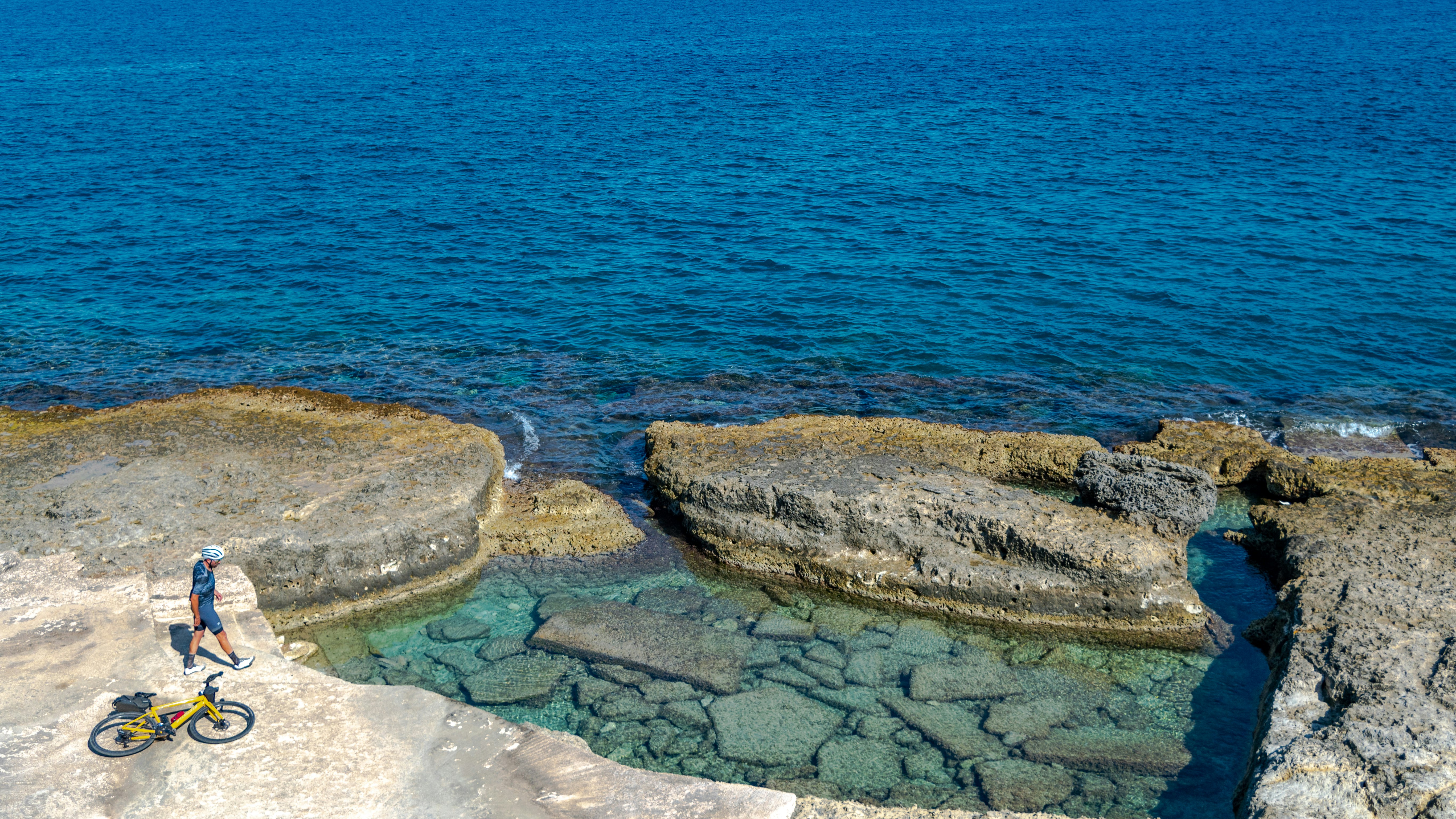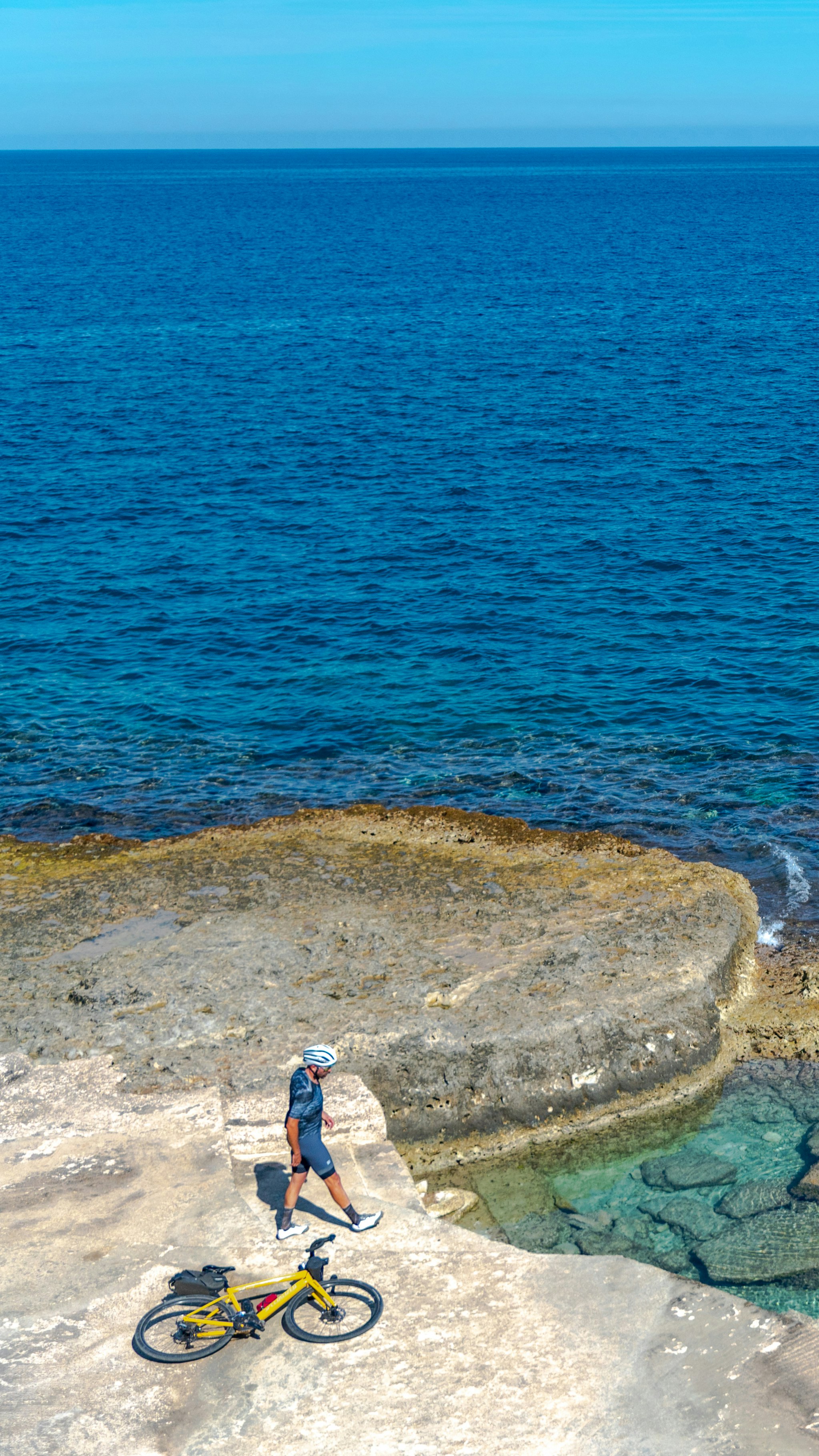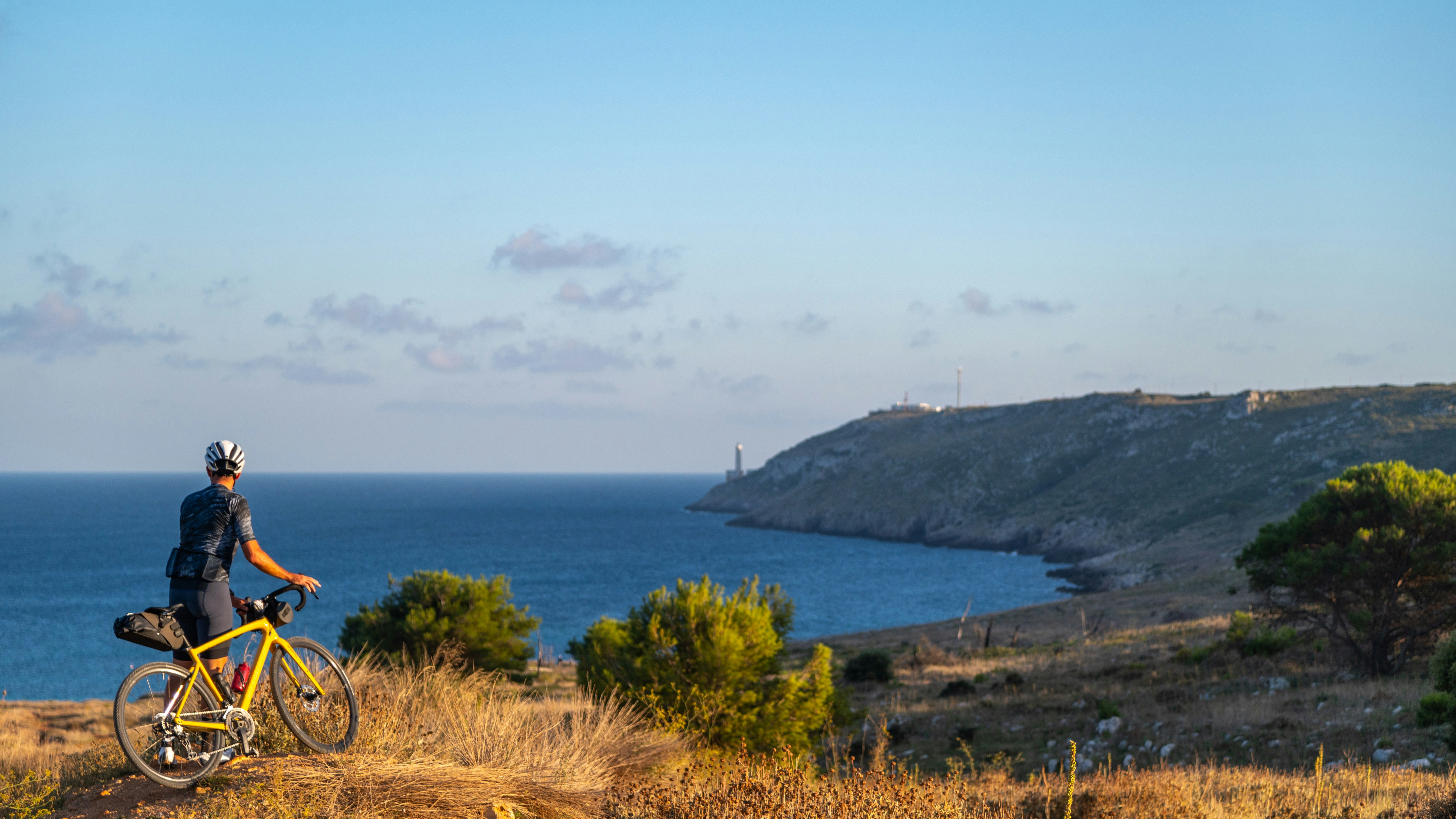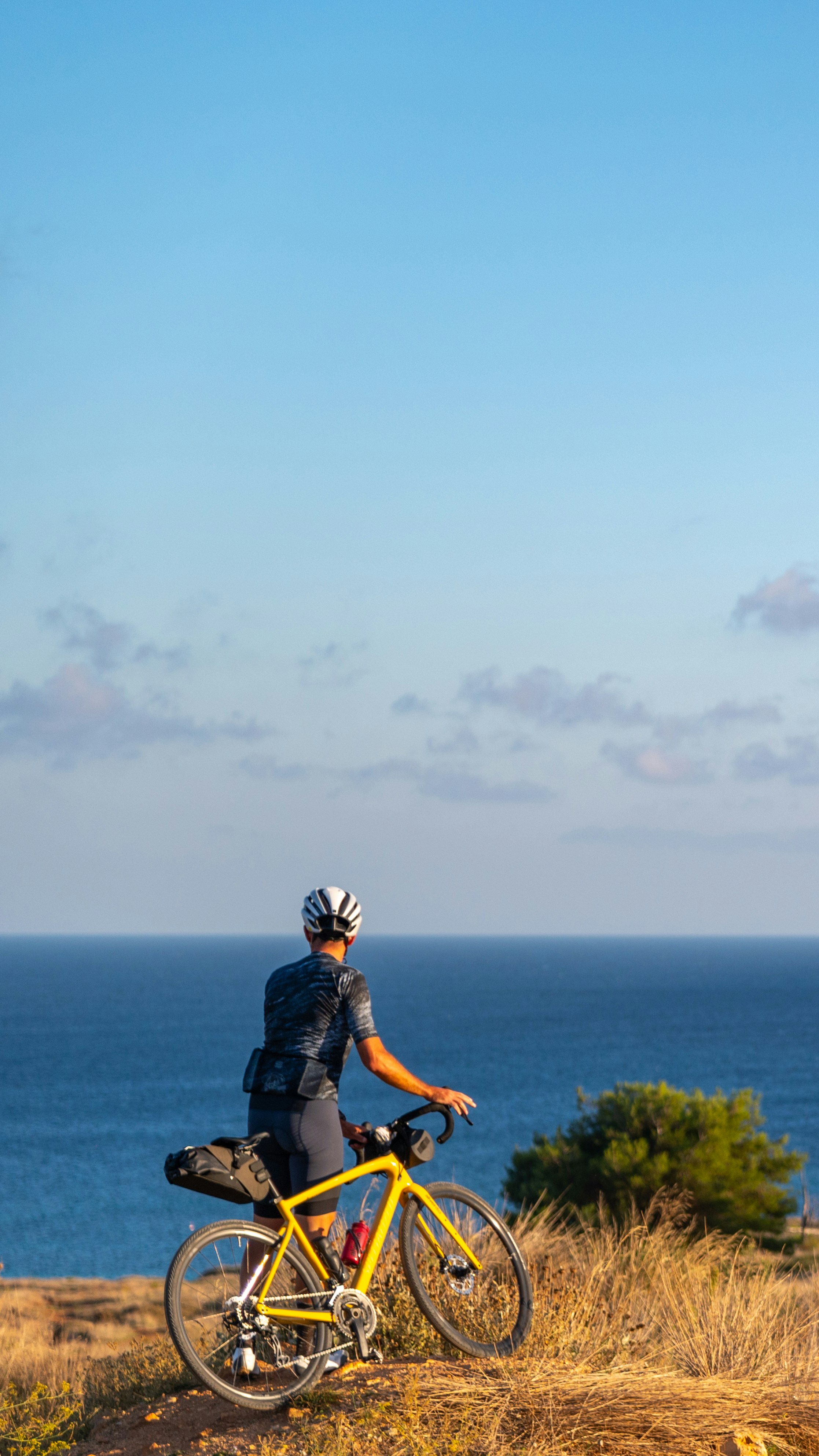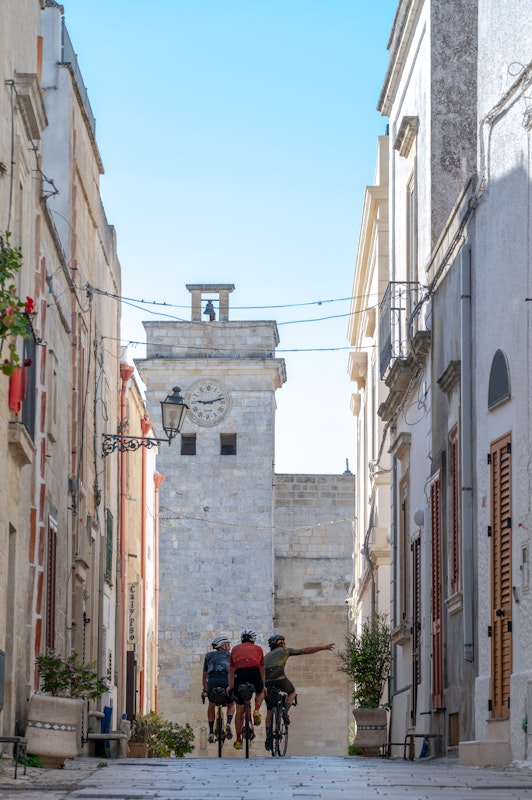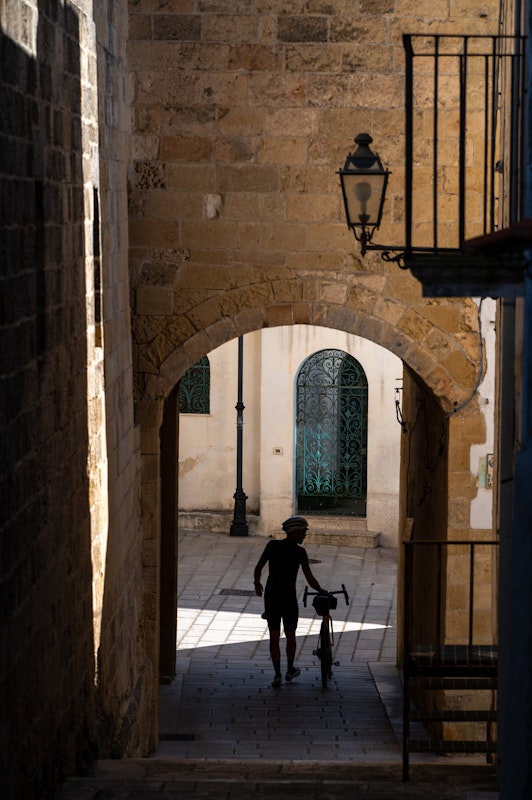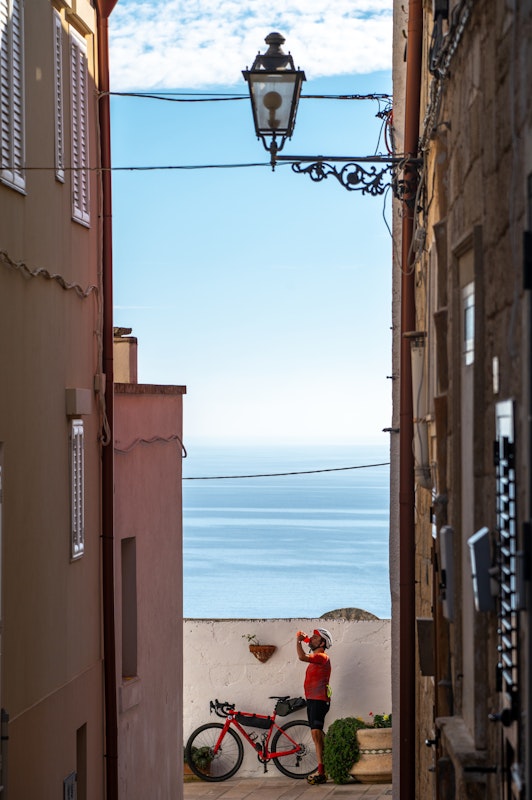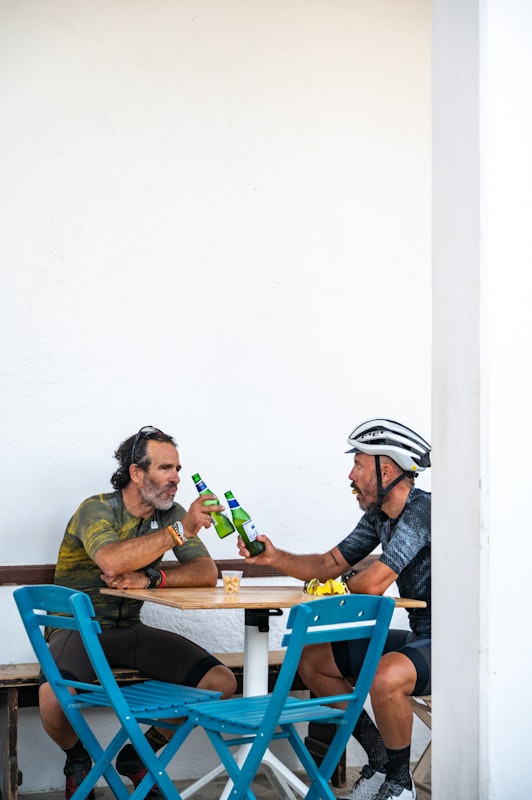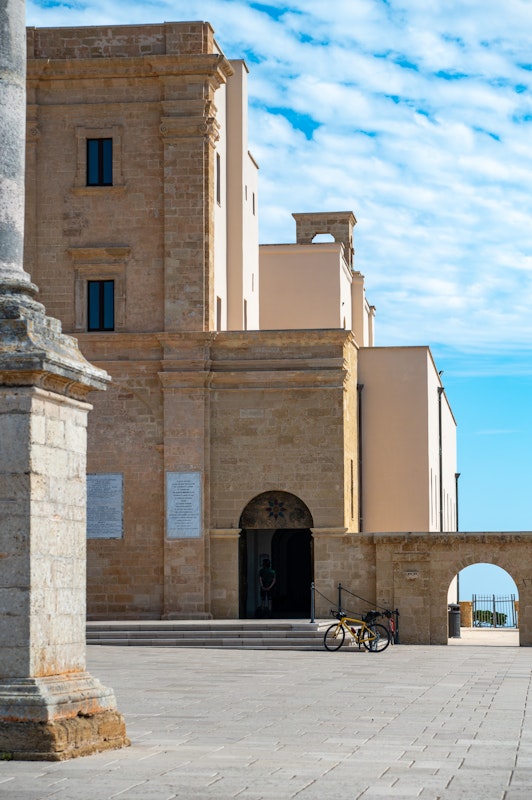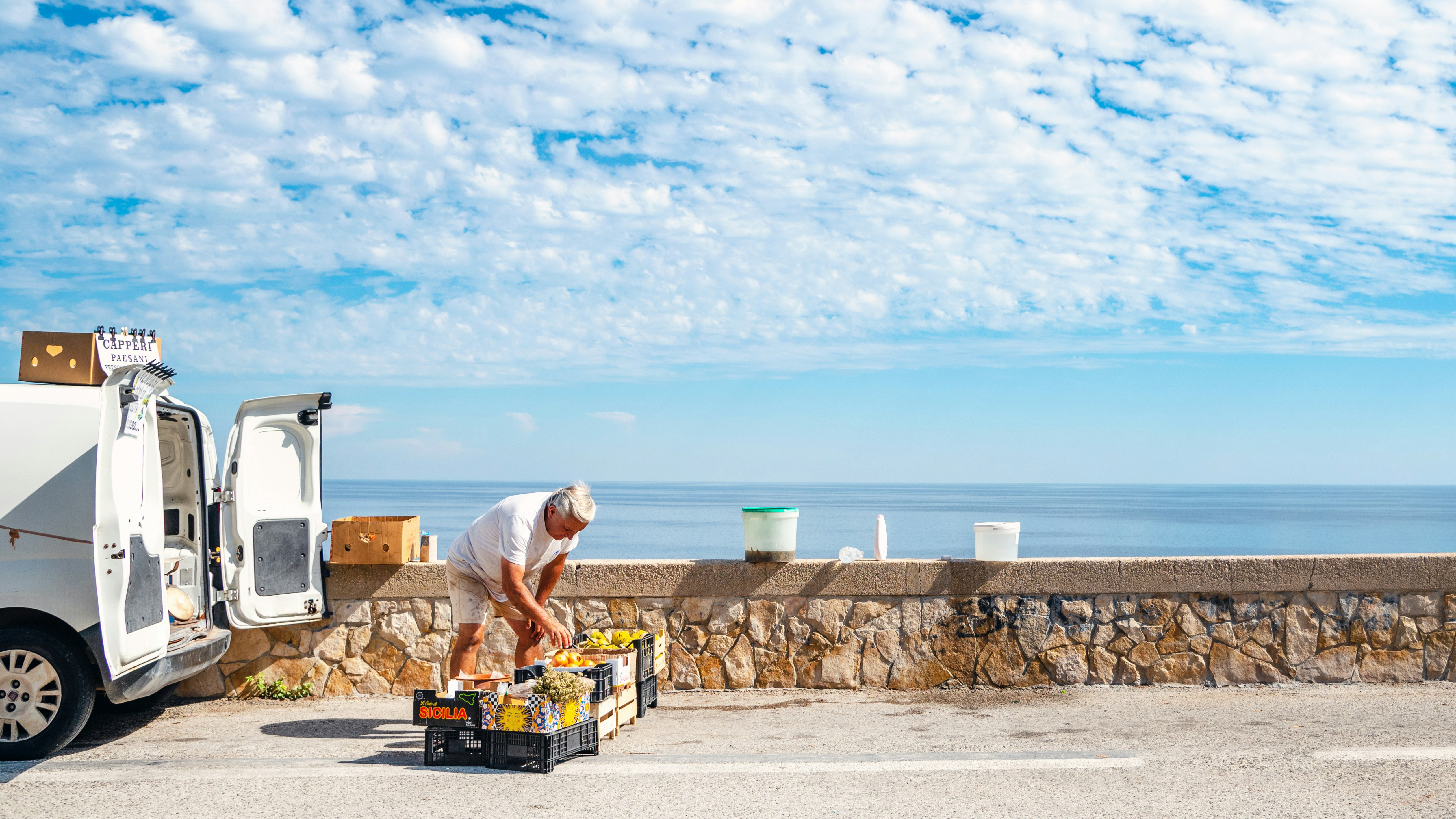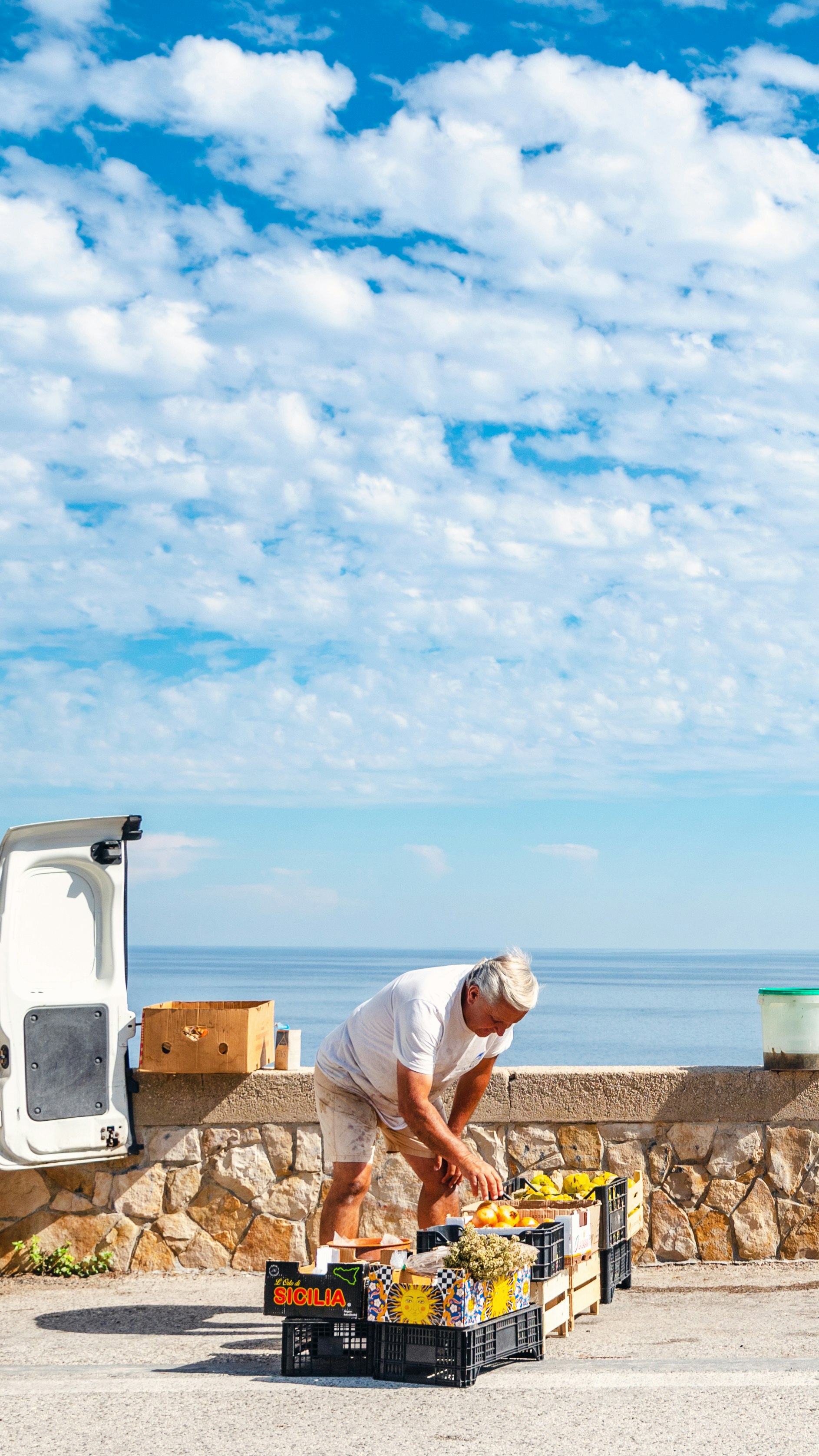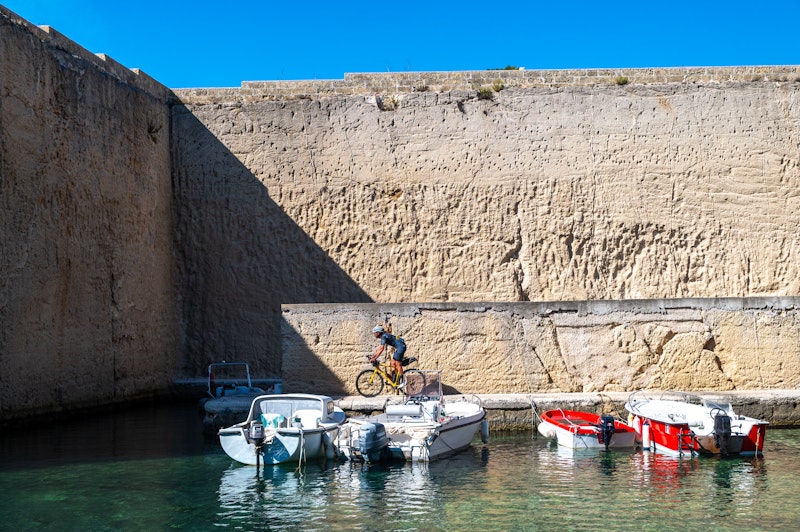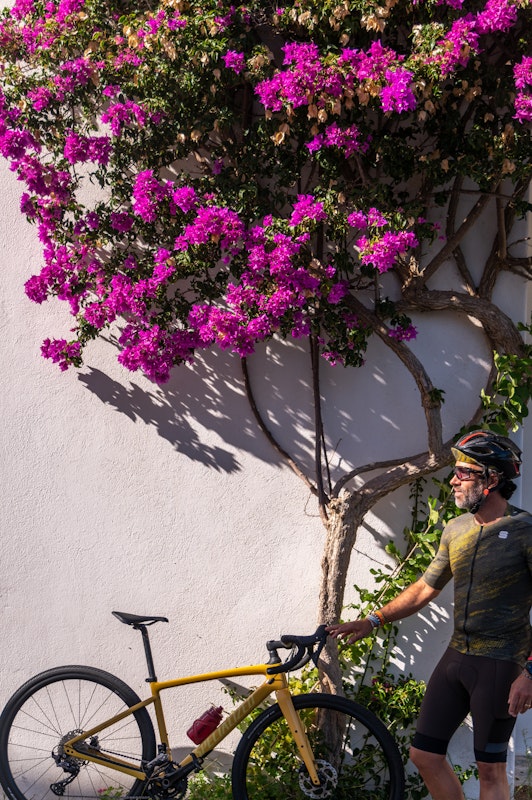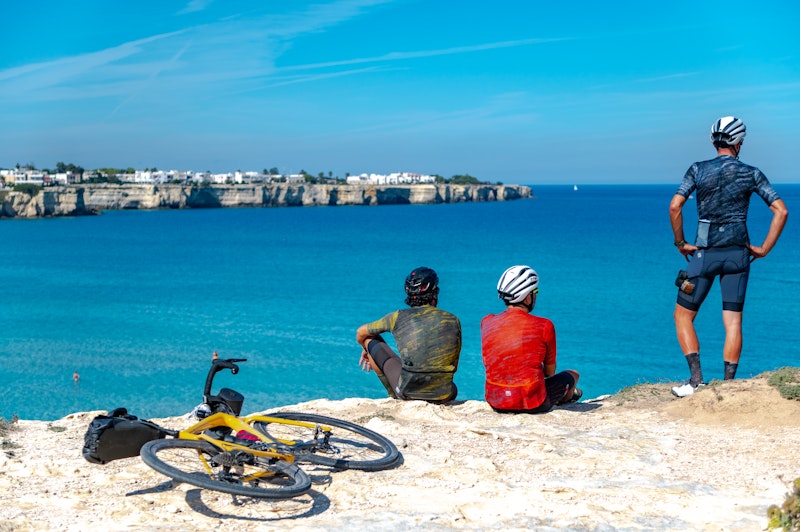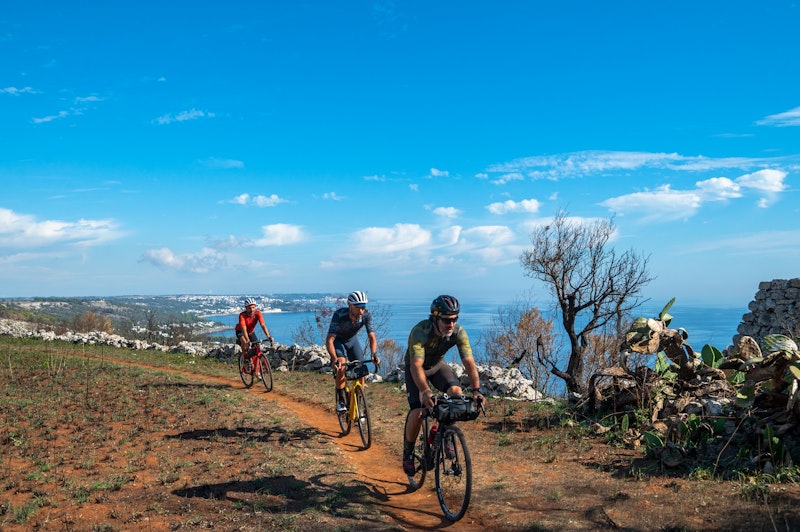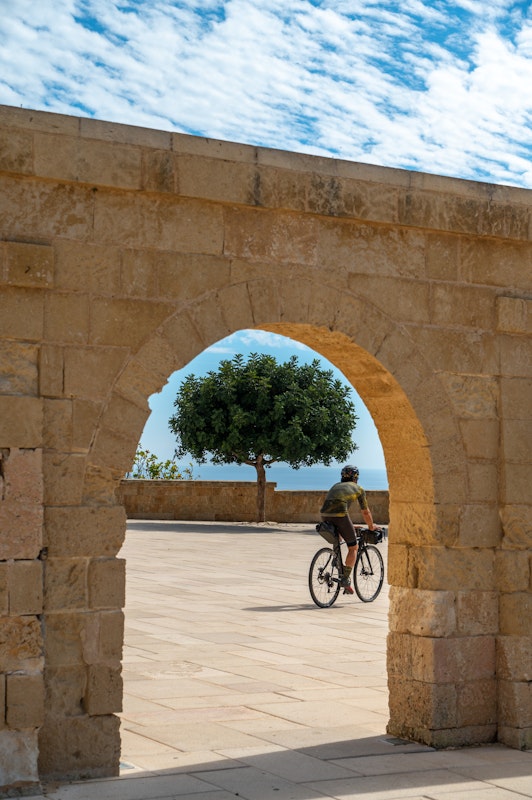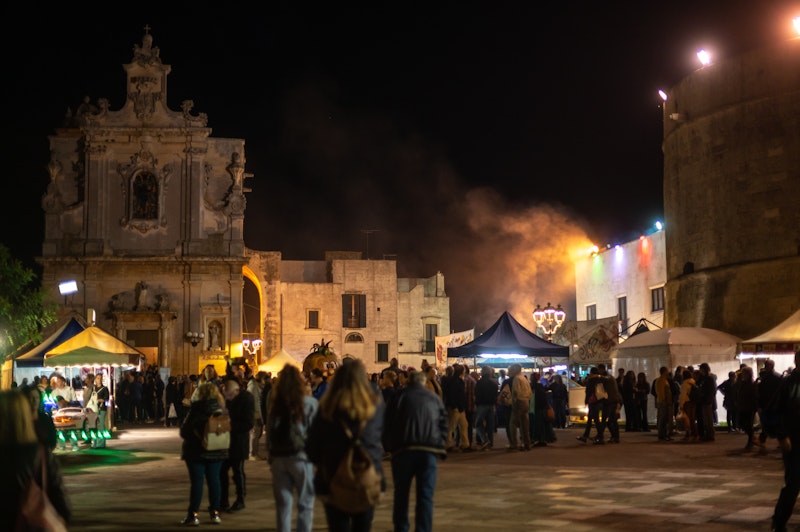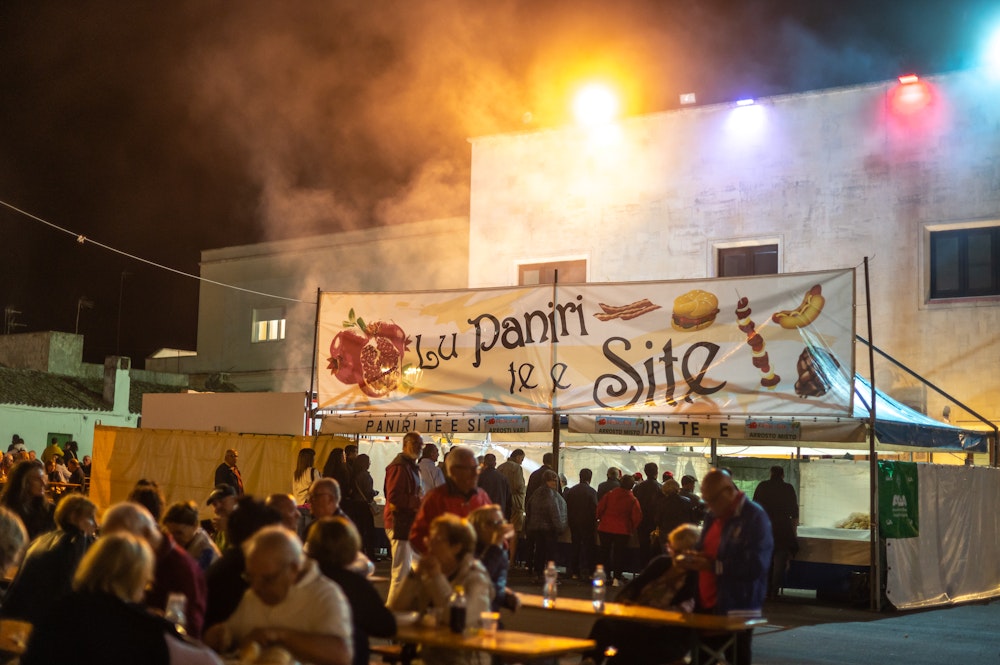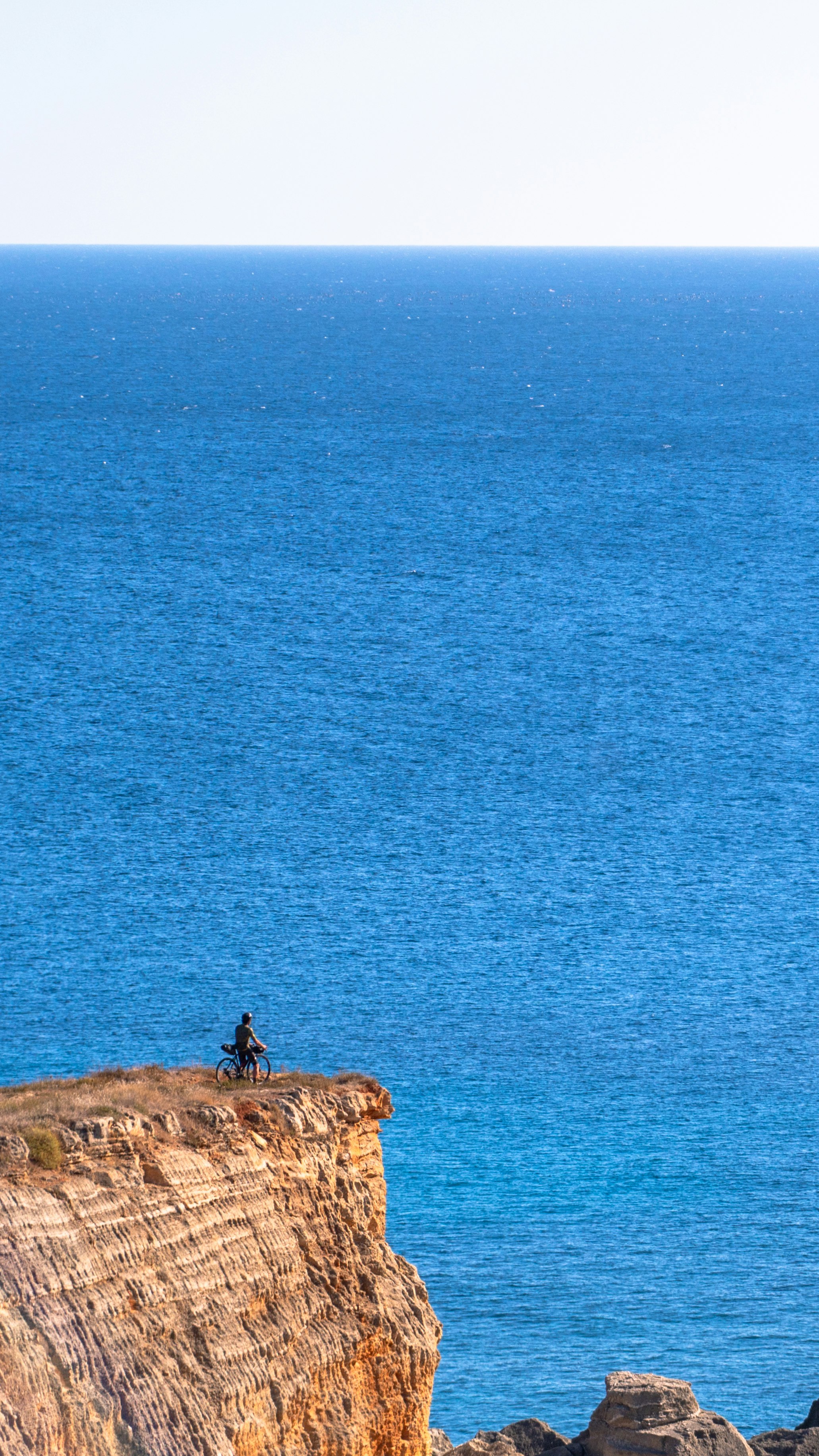
Salento Trail
Olive trees, farms, stacks: pedalling between the two seas.
Elevation difference
2118 m
Total Length
297 km
Duration
2/3 Days
I
Salento Trail
00
Intro
01
Maglie in the middle earth
02
Legends and millenary signs
03
Lu Mare at last!
04
From Otranto to Santa Cesarea
05
Towards the Leuca lighthouse
06
Grand finale
Of course, I could have opted for a quiet trip by plane, or at most by train, but I haven’t seen Alfredo and Sandro for so long that — apart from my luggage and my bike — I can’t just turn up empty-handed. I’ll have to repay them for the invitation!
I load the van and set off. I have more than eleven hours of travelling ahead of me, and as it happens, I am someone who prefers to grind out kilometres in the saddle rather than be stuck behind the wheel. Maybe it’s the excitement, maybe it’s the abnormally warm autumn weather, maybe it’s the early start that allows me to avoid the traffic, but the hours pass quickly. Without realising it, I am already well beyond halfway. At the wheel, my mind is playing out fantasy after fantasy in anticipation of what awaits me, and I realise that I am on a journey within a journey. I am dying to reach my destination.
What awaits me is a place full of history. A strip of land enclosed between two seas, incessantly swept by the wind, where for millennia populations have alternated, each leaving a mark, more or less evident, of their existence and their passage.
I too will cycle through this territory for two days, trying to forget all the worries of everyday life.
“I made it as fast as I could!”
“Shh, be quiet. Everyone is sleeping! Food is over there, bathroom over there, bed over there. And go to sleep early, we start tomorrow!”
Alfredo and Sandro live in Maglie, a town of about 15,000 inhabitants just below Lecce. It is right in the heart of Salento, equidistant from the Adriatic and Ionian coasts — the ideal place from which to begin our short adventure. As always, one loads all kinds of clothes into the car, but then on departure chooses the bare essentials for a stray weekend.
I get up an hour before the others and visit the old town alone, riding my bike and ensuring it is set up to perfection. They will be my last moments of relaxing solitude and I enjoy them, aware that from now on there will be laughter, laughter and more laughter awaiting me, along with sweat as a pleasant leitmotif.
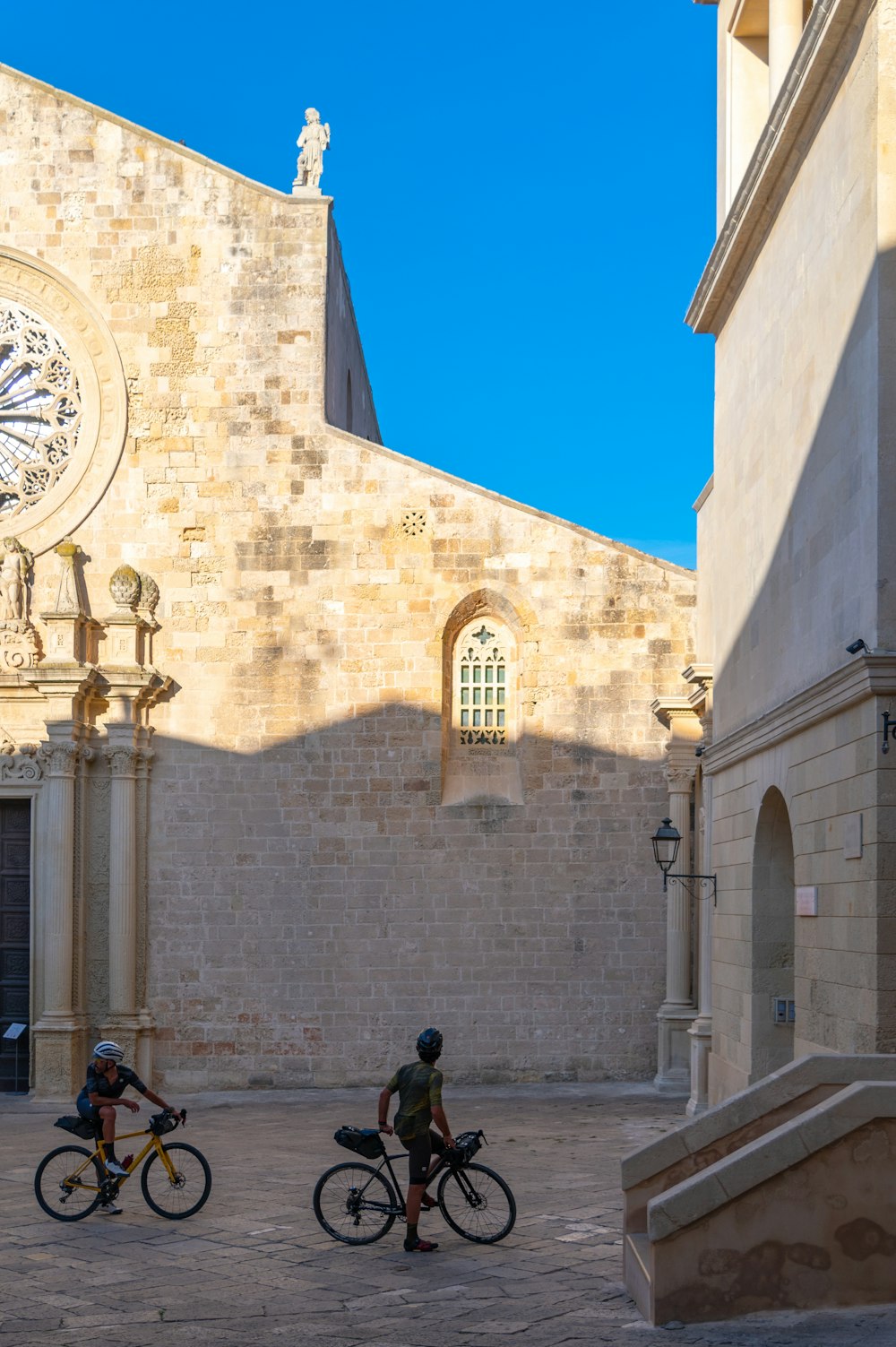
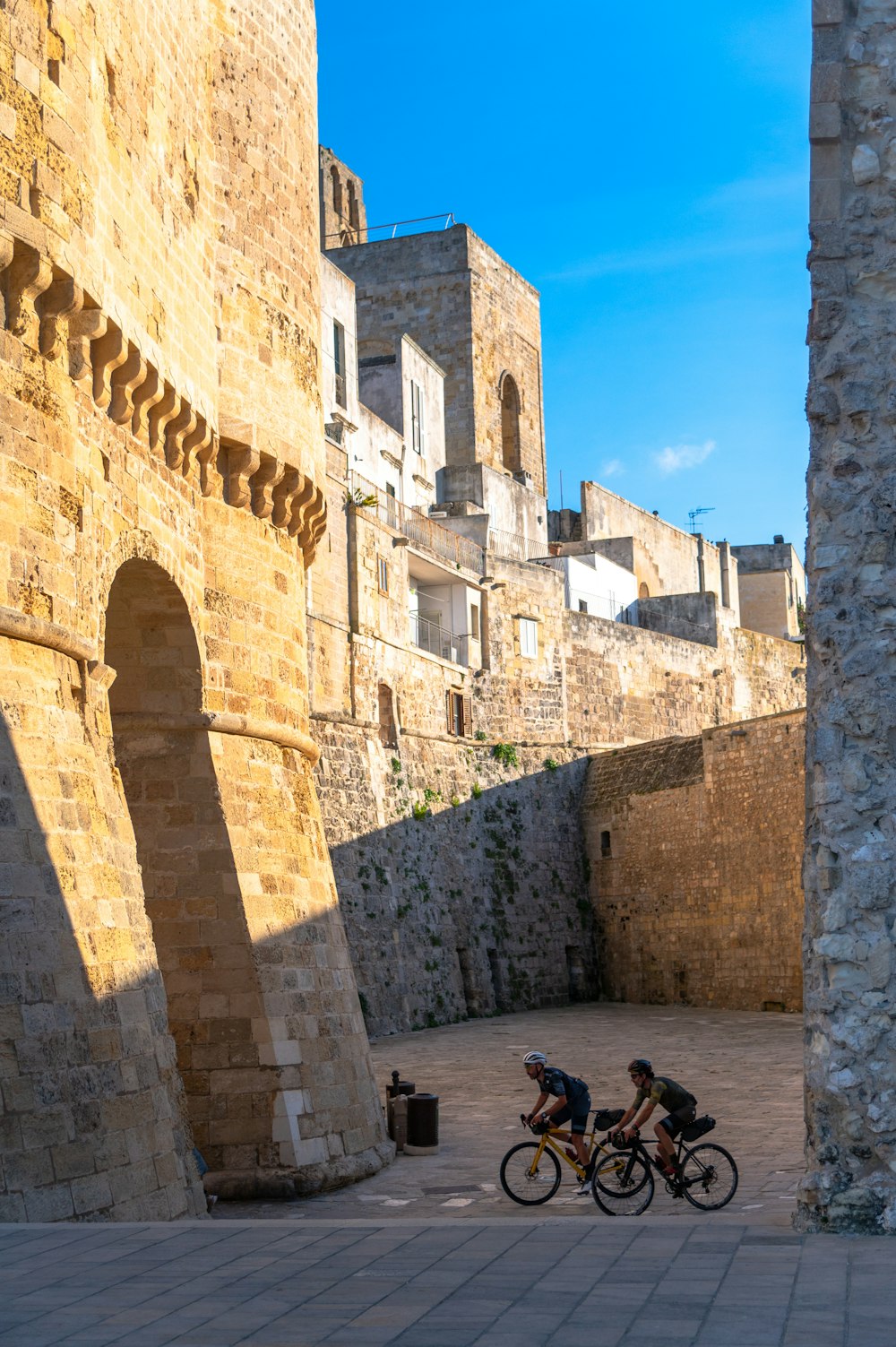
Just a couple of warm-up kilometres and we are already immersed in the history of this land. Strange walls mark the dirt path.
“These are the Messapian walls.
The Messapians built them around 300 B.C. They were a population that settled here in Salento. Their name means “standing between two seas”. Never heard of the Messapians, huh? Don’t worry, hardly anyone knows about them!”
I smile, spread my arms and realise that it will be neither the first nor the last history lesson I will receive during this trip.
The sunrise in Salento is just wonderful. We are still inland, and seeing the fiery-red sun ascend above the horizon to illuminate the olive trees is awe-inspiring. My legs still don’t spin properly, perhaps due to too many hours spent sitting in the van, or maybe because I have to get used to this alternating terrain we’re riding on: asphalt, single track, stones, dirt roads. Everything and more, in short.
We are at the foot of the Collina delle Ninfe e dei Fanciulli (Hill of Nymphs and Children). According to one legend, the olive trees are nothing more than shepherd boys who were transformed by a nymph’s spell. The little boys had dared to challenge the semi-divine woodland creatures to a dance contest. They lost, and their punishment was to be turned into olive trees. It becomes a game at this point, as we pedal along heart-racing double-digit bergs, to try and find human faces in the twisted shapes of olive tree trunks.
We haven’t seen each other for a long time, so we take advantage of every quiet moment to exchange a few words about life, work and family. The temperature is perfect and we are able to pedal and talk without getting breathless.
First a Menhir to act as a crossroads, then a Dolmen where we decide it is time for the first banana of the day. I am amazed by the amount of memories we are encountering, without time to finish listening to one story before immediately starting another.
Fortunately the track is mostly flat and we are almost never at full speed, which allows me to remember exactly what Alfredo and Sandro are telling me in their unusual guise as Cicerone.
An abandoned road where nature is reclaiming its space takes us to Palmariggi, where we fill our first water bottle of the day. Our mouths are dry. We wonder if it is because of fatigue or because we have been talking the whole time. We leave behind the imposing Aragonese Castle, built around 1330 as part of the vast strategic defence system protecting Otranto. We cycle along roads bordered by dry stone walls, among olive and fig trees, until we reach the Torcito Natural Park, after which an imposing masseria of the same name is located. The entire territory here is dotted with masserie, the historic rural settlements typical of the Apulian countryside. But that of Torcito is certainly one of the most beautiful, and all around it are ancient Roman roads that bear the signs of who knows how many centuries of history. You can still see the furrows left by the wheels of carts. Riding through them, on tracks that are perhaps 2000 years old, is not child’s play!
“How strange this vineyard is so low. What grapes are they?”
“They are rooted cuttings. They are vines for grafting. They are planted and then sold to grow various types of grapes.”
You never stop learning, I think.
A strada bianca as smooth as a billiard table allows us to speed along as we see the scenery change around us once again. In an instant everything becomes green and the macchia mediterranea emerges, with trees and low bushes that coexist with sand, scrub and salt. This is where the two lakes of Alimini are situated, another incredible discovery, the existence of which I completely ignored. Alimini Grande, generated by the continuous erosion of the sea, is almost completely surrounded by a rocky strip covered by thick pine forests; next to it is Alimini Piccolo, also called Fontanelle, fed by numerous freshwater springs. Connecting them is a small canal, Lu Strittu. Any explanation of the etymology is superfluous.
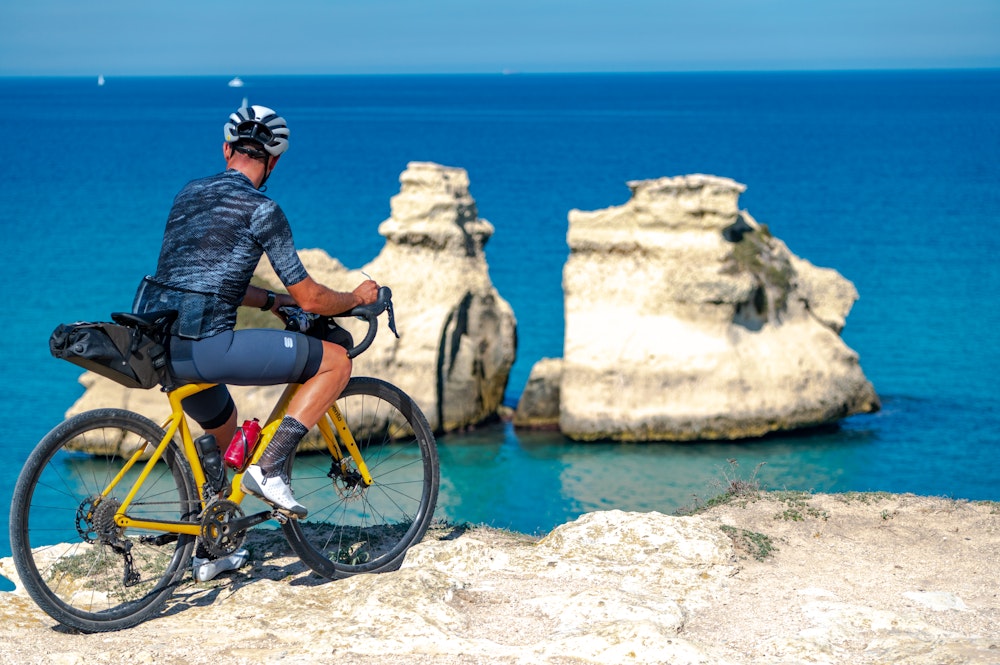
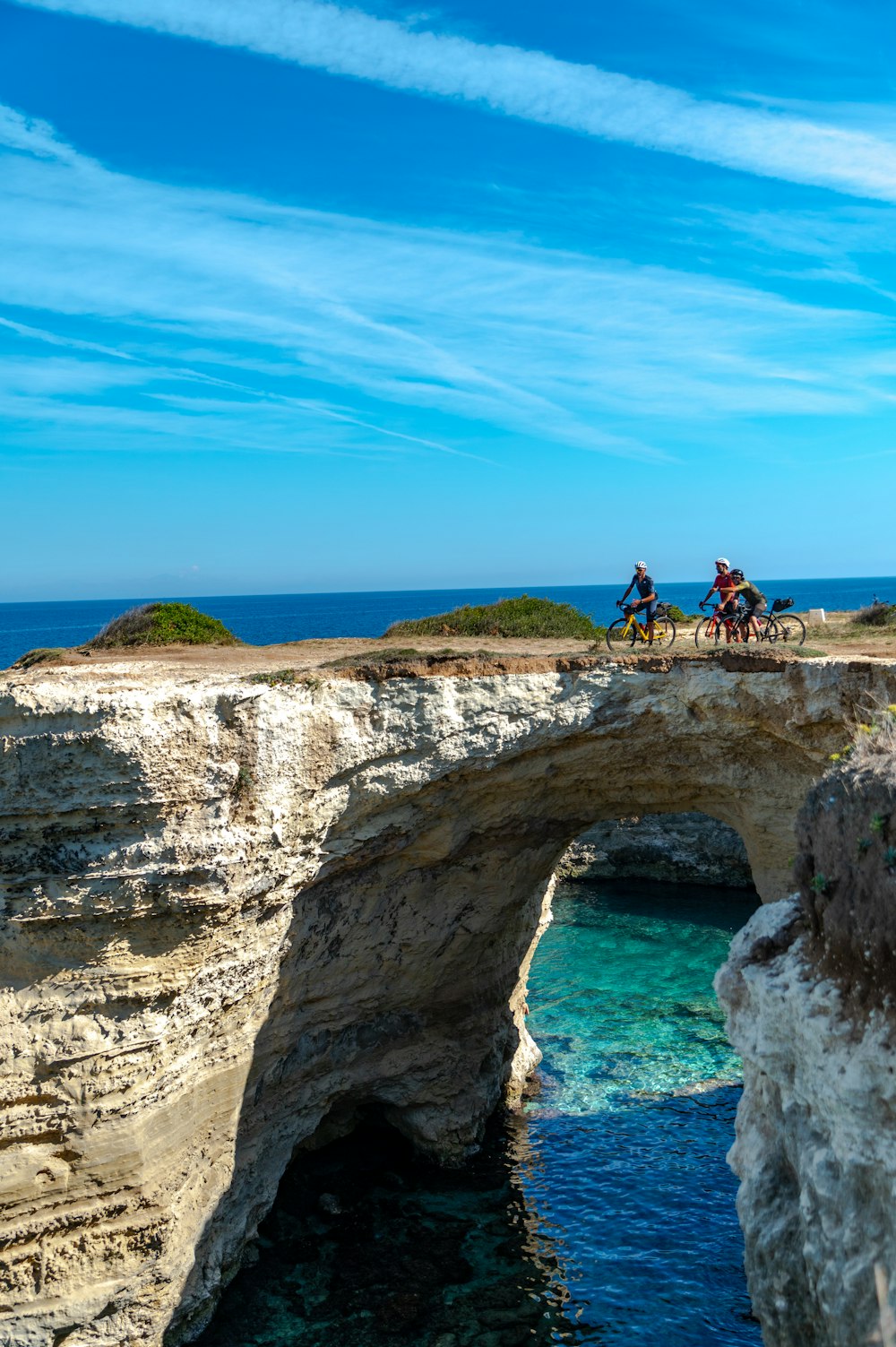
That’s what they call it around here, and that’s what I call it too.
I had always heard about the beauty of Torre dell’Orso, but I never thought it would be anything like this. Crystal-clear water of a deep blue that it is so rare to see. The name comes from the presence of a 16th century tower on the coast, used in the past to spot the arrival of Turkish ships from the sea.
A quick ride on the beach and then up the rocky coast.
“What are those?” I ask with wide eyes.
“The two sisters! Listen well. Legend has it that two local peasant girls approached the sea one day to cool off. Upon reaching the bay of Torre dell’Orso, one of them dived in for a swim, but the water near the rocks became treacherous and swirling. The girl began to drown. Her sister rushed to her aid, but the more they swam, the more vain their efforts became. Finally they hugged each other, exhausted, for the last time, no longer able to overcome the fury of the sea that engulfed them. However, the God of the sea was displeased, and moved by compassion, transformed them into two faraglioni, side by side for eternity.”
I don’t think of myself as a particularly emotional person, but I must admit that imagining the scene and having the poignant sight of the two faraglioni in front of me made my heart soften.
The road from here to Otranto is incredible. A single track of a few kilometres with the sea just a few metres away, first under the scorching sun and the rest under the shelter of tree cover. Obviously the speeds cannot be high, but it is a real treat.
Entering Otranto has a flavour of its own. Maybe it is the beauty, maybe it is the influence of the Turkish occupation in 1480 and the trail of blood it left behind. This trip is a mix of sensations, I think to myself. The alleyways of the historic village, well-kept and sometimes sloping with gradients in double figures, make us work hard. Riding through them is a privilege.
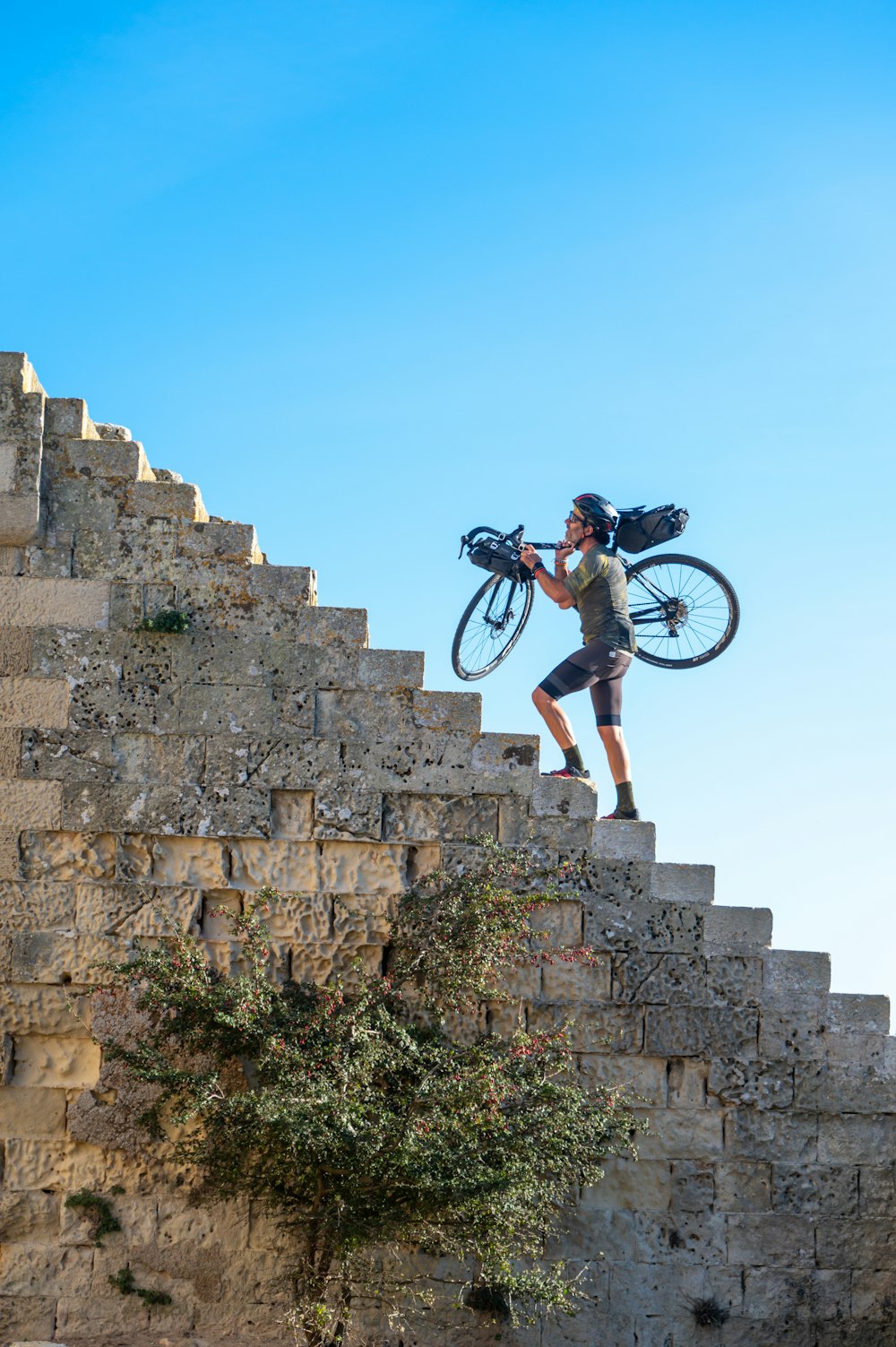
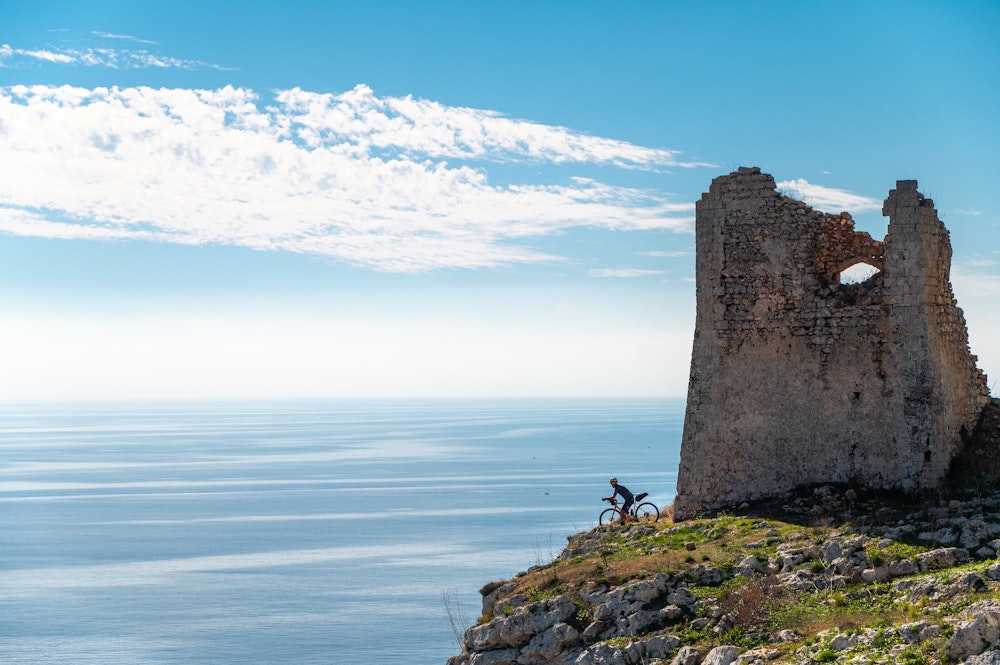
Tiredness is setting in and the second part of the day begins by passing Punta Palacia, the easternmost point in Italy — just five kilometres from the town. It is here that the coast road begins, which we won’t leave again until Santa Cesarea Terme. I breathe a sigh of relief because a bit of tarmac is now truly blessed. Little does it matter if the road is a continuous mangia e bevi, as the pleasure of feeling my legs turn so well relieves all fatigue and allows me to relax without constantly looking at the ground. I see Sandro and Alfredo confabulating and understand that something is about to happen. A couple of small diversions and bang — Masseria Cippano appears before my eyes. A tower about 15 metres high with a spectacular staircase for access. It is no coincidence that it has been chosen as the setting for several films.
We arrive in Santa Cesarea Terme with the sun going down. The sea is calm and the view is phenomenal. You can immediately tell that it’s a thermal place by smelling the air, which makes it unique. The initial idea was to stop here for the night, dividing the route into three days. But partly because my legs are spinning nicely and partly because of the wonderful light of the sunset, we decide to grind out a few more kilometres.
The streets of Castro plunge me into another world. The yellow tones give way to brighter, more vivid colours, almost reminiscent of those on the Greek islands not far from here.
Now we are really exhausted and decide it is time for a break.
When we wake up, the decision is made: the tour will be completed in just two days. We are just under halfway through the route, so it is doable. Moreover, what remains is easier, smoother and there are fewer places of historical interest to visit. The landscape will be the main factor today and this will hopefully allow us to fly.
“What’s that? Albania?”
“You are really lucky! The wind has cleared the air and the coast is clearly visible! It happens frequently, but not that often. If there had been sirocco it would be hidden, but it looks like you’ve brought the northern air!”
I enjoy the view as I apply copious amounts of sunscreen to my face. Down here the sun hits hard until late autumn, and seeing the golden skin of the many cyclists encountered on the road, I have no trouble believing it.
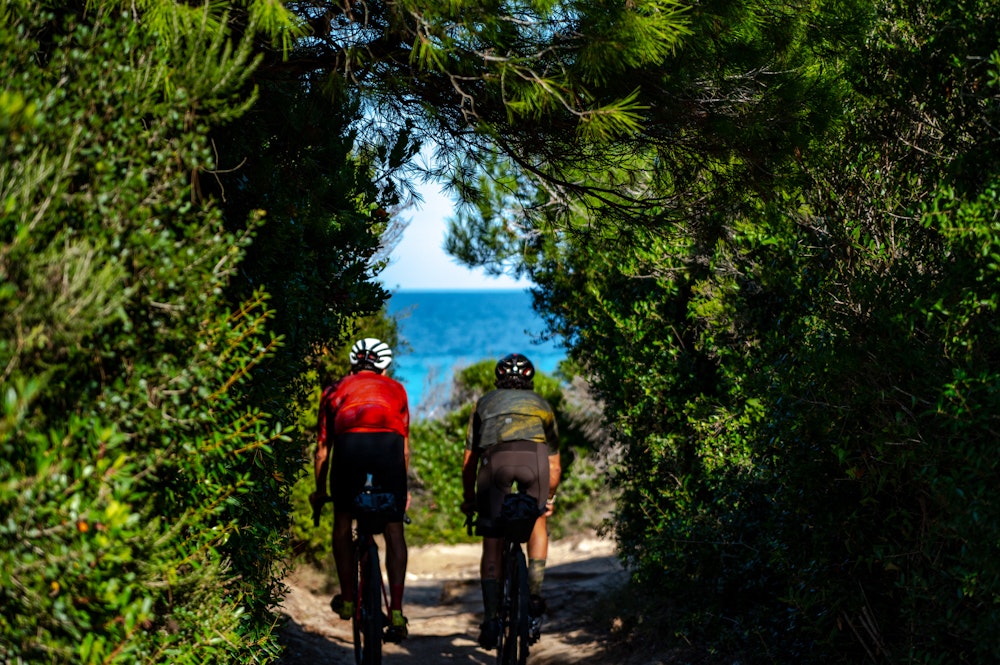
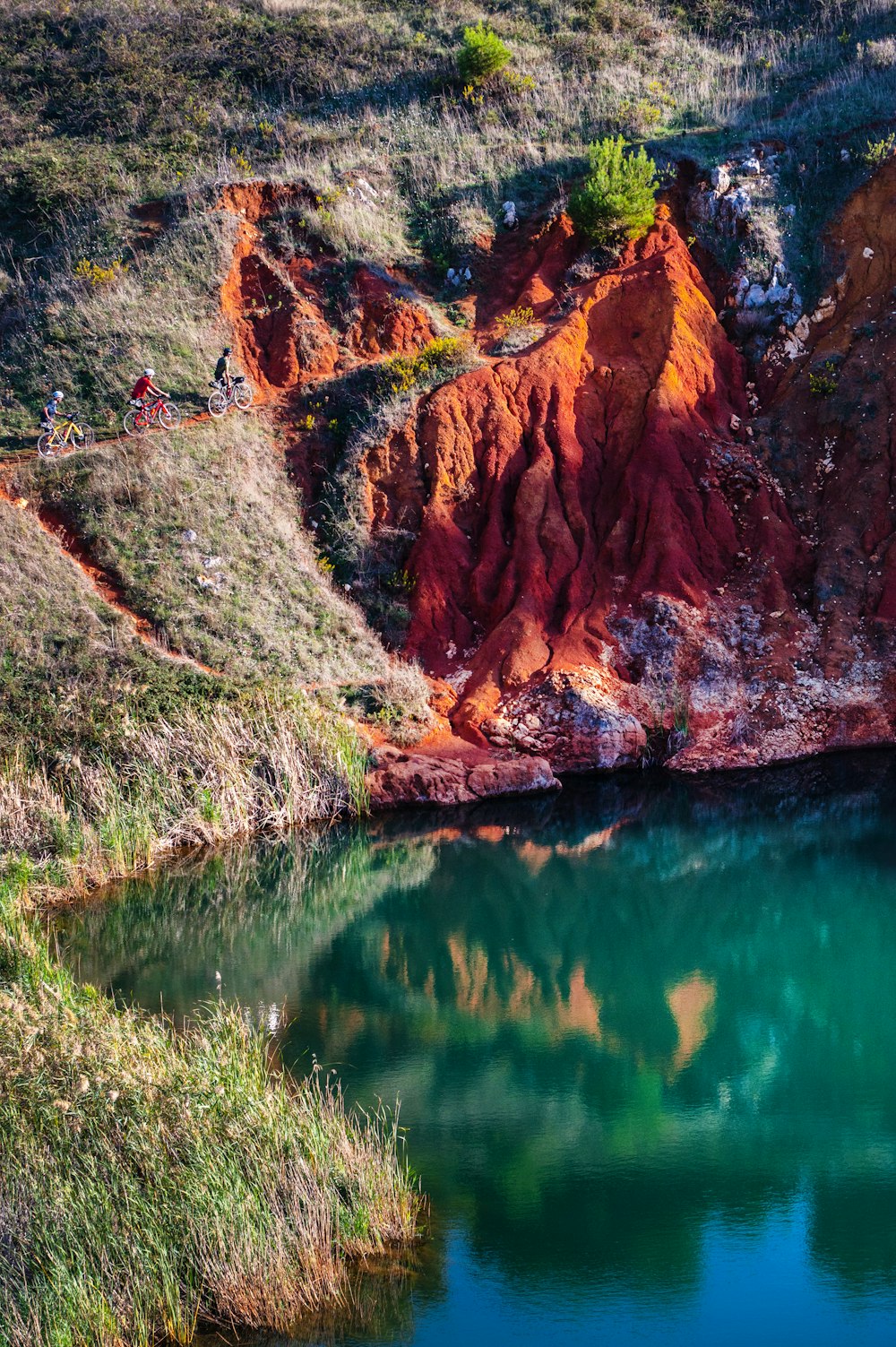
Another single track on the crest, on the Serra del Mito, gives us a chilling panorama as far as Torre del Sasso. Whilst looking down from up here, I reflect. If they had to build so many lookout points, it is because this was a coveted spot. Seeing its beauty, I am not surprised.
I don’t know about you, but lighthouses have always fascinated me. It might be something ancestral since they have always been borderline places, but also indications of the right route and sometimes synonymous with dry land and shelter. I don’t know, but arriving at the Leuca lighthouse by bike enriches me with a feeling that is difficult to explain.
I knew that nature would take over today, and so it did. From Leuca, we set off up the coast towards the Ugento Coastal Park, which is quite an unusual place. Sand dunes, marshes, macchia mediterranea and the Serre di Ugento: hill formations of limestone rock, etched from time to time by gravinelle, karstic gullies parallel to each other but perpendicular to the coast.
The idea of cutting the route has crossed my mind more than once. Not so much because I was tired, but because of the multitude of landscapes and views seen over these two days. I felt so satisfied so many times that I thought it would be enough. Luckily my two companions did not want to indulge me, despite my repeated requests. Since the first phone calls over a month ago, they have been talking to me about Specchia, the last stop before the conclusion of the weekend. They must have repeated it to me at least a dozen times already.
We get there tired, hot and hungry, but luckily I have listened to their insistent requests. Two sharp switchbacks, a 90-degree bend, and we reach the top. It’s no Cima Coppi so to speak, but the view all around is truly spectacular.
It is the last break, the last moment of relaxation before the final stretch that takes us back to Maglie. I am satisfied and serene. There is not much left, but enough to enjoy a little more. The sun goes down, the temperatures also, and we become more taciturn. I don’t really know what the last few kilometres will be like and I don’t even want to imagine them, nor do I ask Sandro or Alfredo any questions.
“We have to go, it’s late! We didn’t tell you, but tonight there is the Sagra de Lu Paniri te e Site! We’ll take you there. You’re hungry, aren’t you?”
I close my eyes, open them again, smile, and jump into the saddle. We fly.
How wonderful, this Salento!
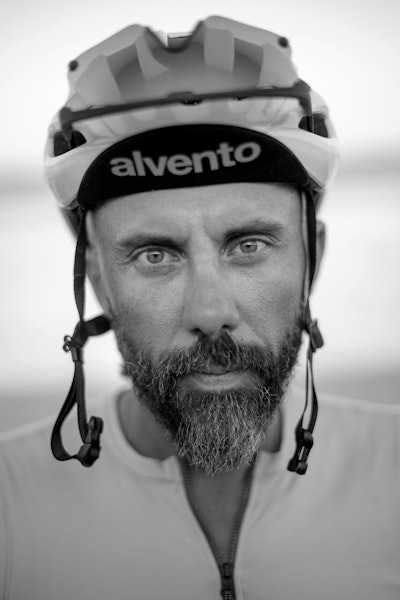
Texts
Stefano Francescutti
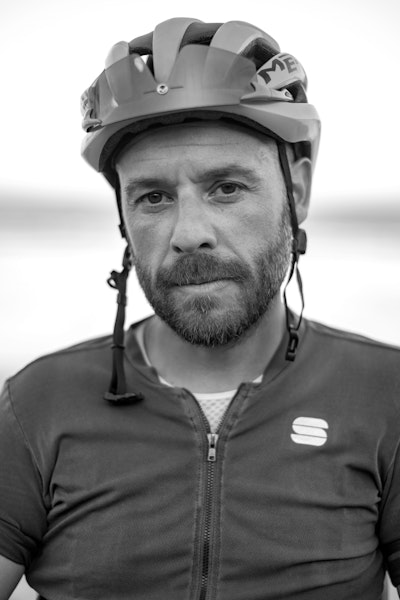
Photos
Paolo Penni Martelli
Cycled with us
Stefano Francescutti, Alfredo Russo, Sandro Toma
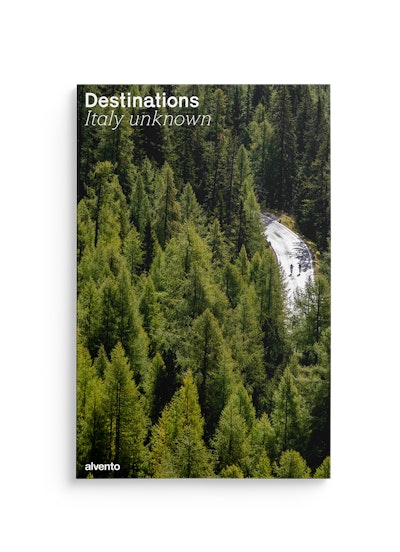
This tour can be found in the super-magazine Destinations - Italy unknown / 1, the special issue of alvento dedicated to bikepacking. 13 little-trodden destinations or reinterpretations of famous cycling destinations.
